
 |
Eager Space | Videos | All Video Text | Support | Community | About |
|---|

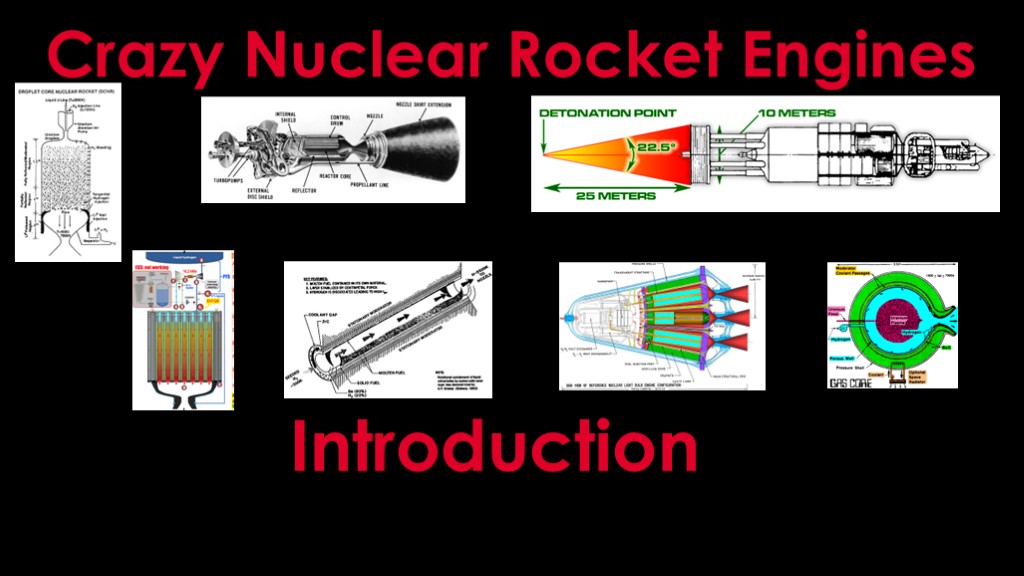
Welcome to the Crazy Nuclear Rocket Engines series.
We will be talking about a number of different engine designs of varying degrees of craziness, but there is some important background information to cover before looking at specific designs. That is the purpose of this video.
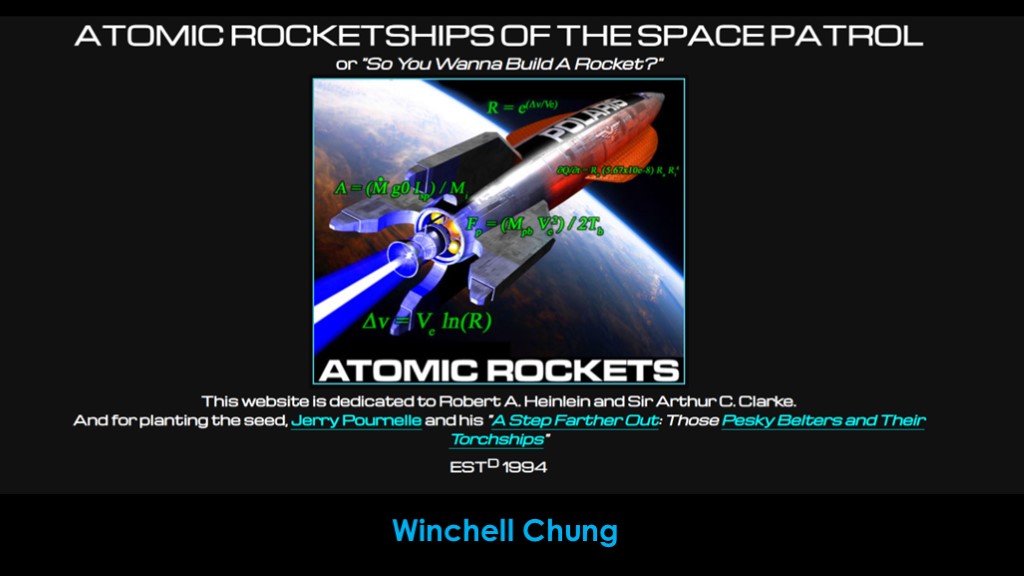
I am hugely indebted to the "Atomic Rocketships of the Space Patrol" website by Winchell Chung.
It contains a huge amount of information about all the engines I'll be covering, including links to the source material. It's just a fabulous reference for what is science fact, what is science fiction, and how the two intersect.
There's a link in the video description.
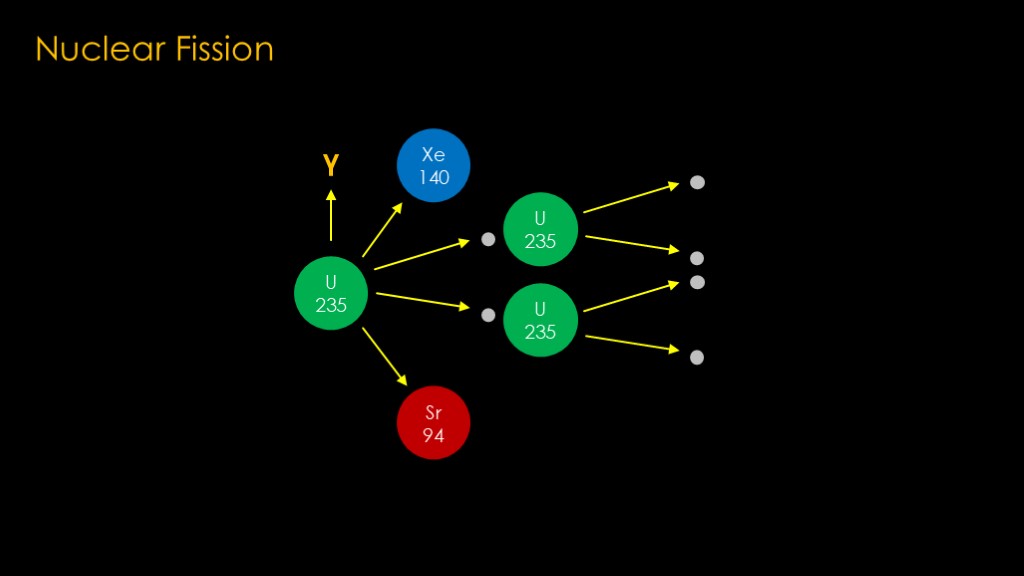
To talk about nuclear rockets we need to understand nuclear fission. There are a few different elements that might be used as nuclear fuel, but uranium is the most common, specifically uranium 235.
The 235 is important as this specific kind - or isotope - of uranium is much less stable than the more common uranium 238.
A Uranium 235 atom has a chance of spontaneously breaking apart. When that happens, we get:
Two new atoms made up from the protons and neutrons that were in the original atom. Here it's xenon 140 and strontium 94, but the elements created vary.
There is also a gamma ray created, a photon of very high-energy radiation.
And there are also a few neutrons created. If these neutrons hit other atoms of uranium 235, they will cause those atoms to break apart, or fission, releasing more neutrons
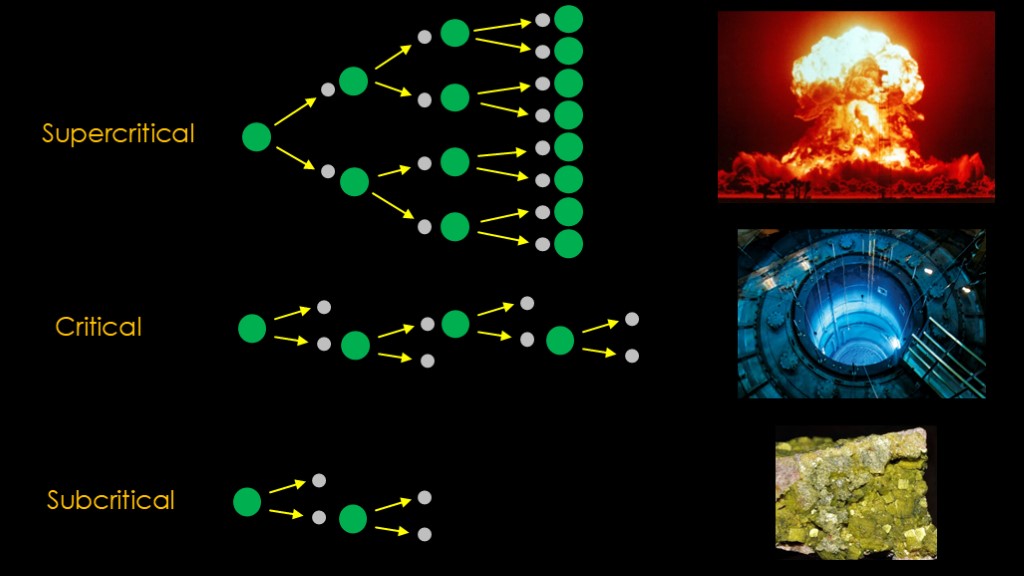
There are three things that can happen after that initial fission:
In the first case, the first fission produces two neutrons and one of those finds another uranium 235 atom to fission, but after that there is no more fission. The reaction just dies. This is known as "subcritical"; the uranium is mostly just sitting there, as it is in uranium ore.
In the second case, one of the neutrons from each fission causes another atom to fission, so there is a steady level of fission activity. This is known as Critical, and this is where nuclear reactors are operating when they are in a steady state. There might be a little or a lot of fission happening, but the rate is steady.
In the final case, more than one neutron from each fission causes another atom to fission, so the amount of fission going on is increasing. This is known as "supercritical". If this increase is fast enough, we end up with a nuclear explosion.
It is therefore important to control the reaction so it continues at the desired rate.
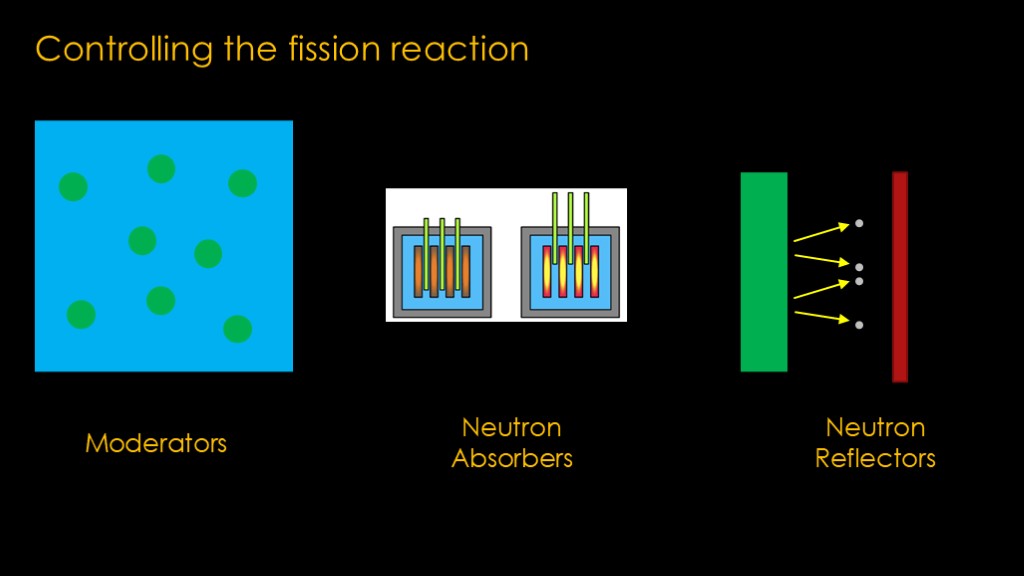
There are various ways to control the speed of the reaction.
If we have a collection of uranium atoms that are subcritical, we can surround them with water. The neutrons will collide with the hydrogen atoms in the water and slow down, and that increases the chance of each neutron causing another fission. Graphite can also be used for this purpose. These are confusingly called "moderators" because they slow down (moderate) the speed of the neutrons, but they *increase* the rate of reaction.
There are other chemical elements - such as boron or cadmium - that absorb neutrons. They are used in control rods in nuclear reactors; drop them down into the core and they will absorb neutrons and reduce the rate of the reaction.
There are other elements that can reflect or scatter neutrons. If we have a nuclear reactor, the neutrons that come out the side of the reactor core are lost. If we put a neutron reflector like Beryllium next to the core, some of the neutrons will be scattered back to the core and be able to cause further reactions.
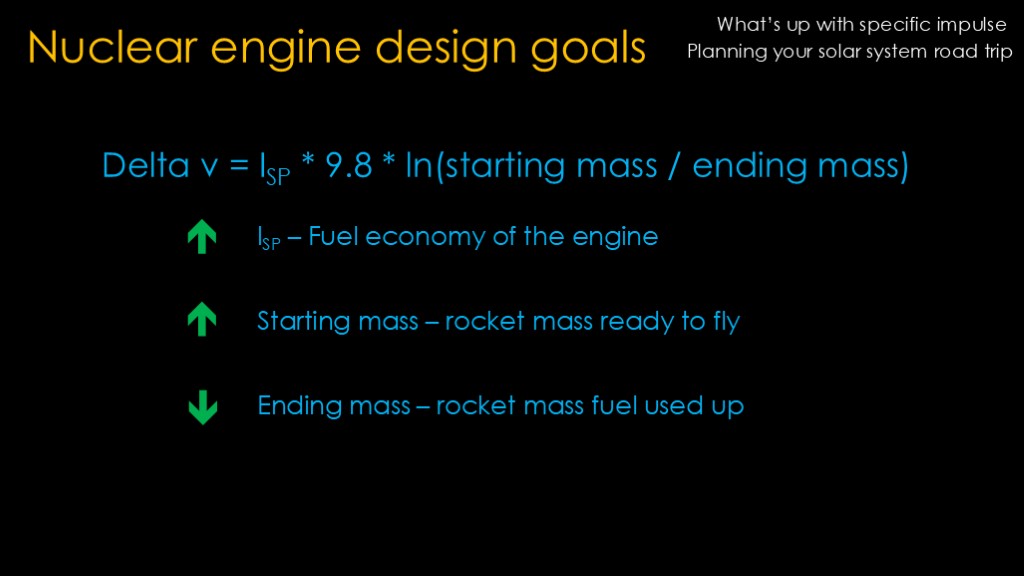
To understand what these engine designers are trying to do, we need to understand what make a rocket engine good.
I'll link two videos for background.
What's up with specific impulse talks in depth about what specific impulse is and what affects it.
Planning your solar system road trip explains why you should care about delta v.
Delta v is a measurement of the useful work that we can get out of a rocket. It is defined as the specific impulse times 9.8 times the natural logarithm of the starting mass over the ending mass.
The specific impulse - generally written as Isp - is a measure of the fuel economy of the engine - how much useful work is available for a given amount of propellant.
Starting mass is the mass of the rocket or stage all fueled up and ready to fly.
And ending mass is that same rocket or stage when it has burned up all of it's fuel.
Starting mass divided by ending mass is sometimes known as the mass ratio.
We want more delta v. There are three main ways that we can do it.
We can use an engine that produces a higher specific impulse
We can create a rocket that has a higher starting mass by packing more propellant into it.
Or we can create a rocket that is lighter with a lighter airframe or lighter engine.
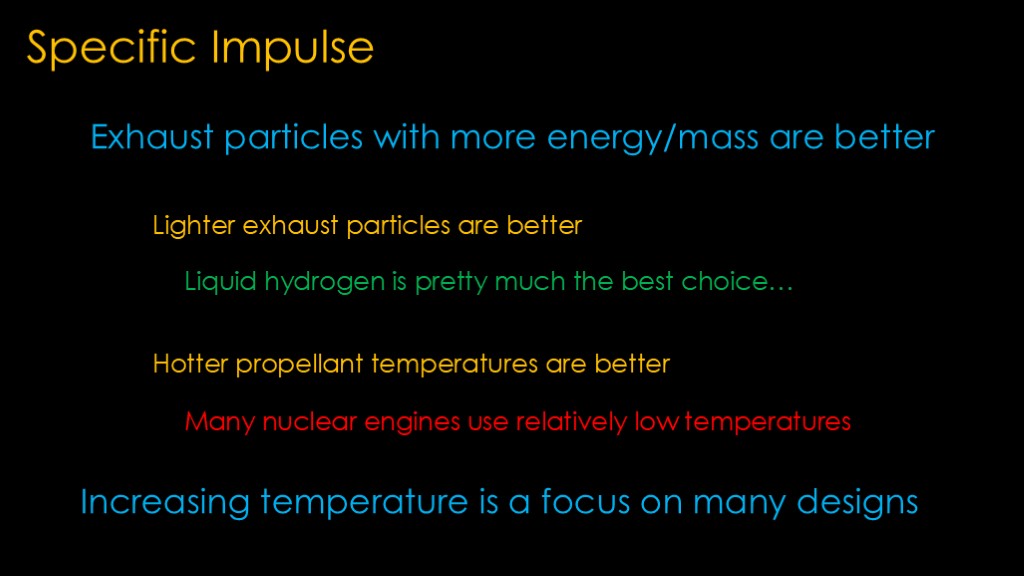
Looking at specific impulse in more depth.
Exhaust particles with more energy per unit of mass lead to a better specific impulse.
There are two main rules:
The first is that lighter exhaust particles are better, so using propellants with light atoms is better than heavy atoms.
Nuclear thermal rockets might use different propellants, but they generally use liquid hydrogen, as it gives the lightest exhaust particles. This gives them a big advantage over chemical rockets.
The second rule is that hotter propellant temperatures are better as it means more energy per exhaust particle.
Unfortunately - for reasons we'll explore in later videos - many nuclear engines use relatively low temperatures, which reduces the specific impulse they produce. Since they already use the best propellant choice, the focus of designers is on creating hotter propellant temperatures.

Now looking at mass ratio
Higher mass ratio yields better delta v
The first rule is that lighter engines and structures are better.
Unfortunately, everything in the nuclear rocket is heavy. The nuclear core is heavy, all of the shielding is heavy, and the supporting structure is heavy. All that mass means the ending mass of the rocket is greater.
The second rule is that more propellant mass is better. Unfortunately, hydrogen propellant is not dense, so you can't put much into a given size tank.
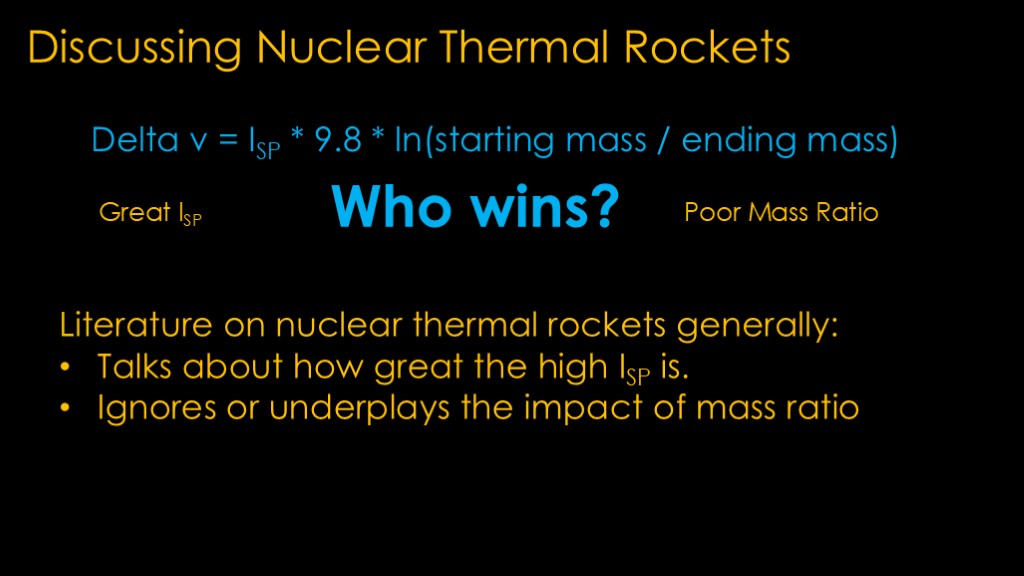
What we end up with is an engine with great specific impulse and poor mass ratio. Who wins? Well, it depends on the details - exactly what specific impulse you get and how heavy your engines and tanks are.
This isn't clear without looking at the numbers for a specific scenario.
To overgeneralize, nuclear thermal literature:
Talks about how great the higher specific impulse is.
Ignores or underplays the impact of mass ratio

If you enjoyed this video, please check out the atomic rockets site.
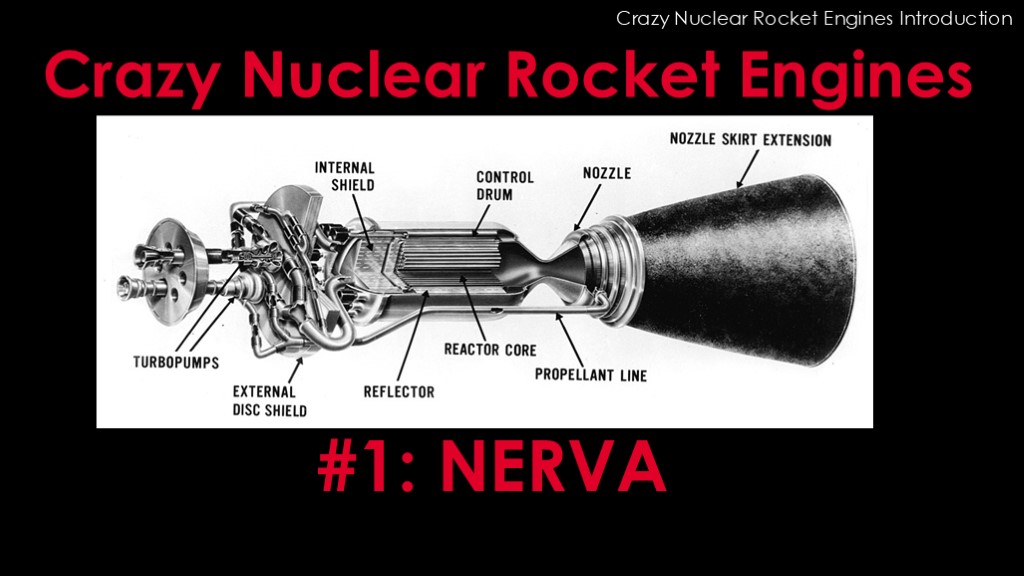
Welcome to Crazy Nuclear Rocket Engines Episode #1.
We will start with the first nuclear rocket engine, NERVA. If you haven't watched it yet, I highly recommend watching the crazy nuclear rocket engines introduction first.
https://www.youtube.com/watch?v=eDNX65d-FBY
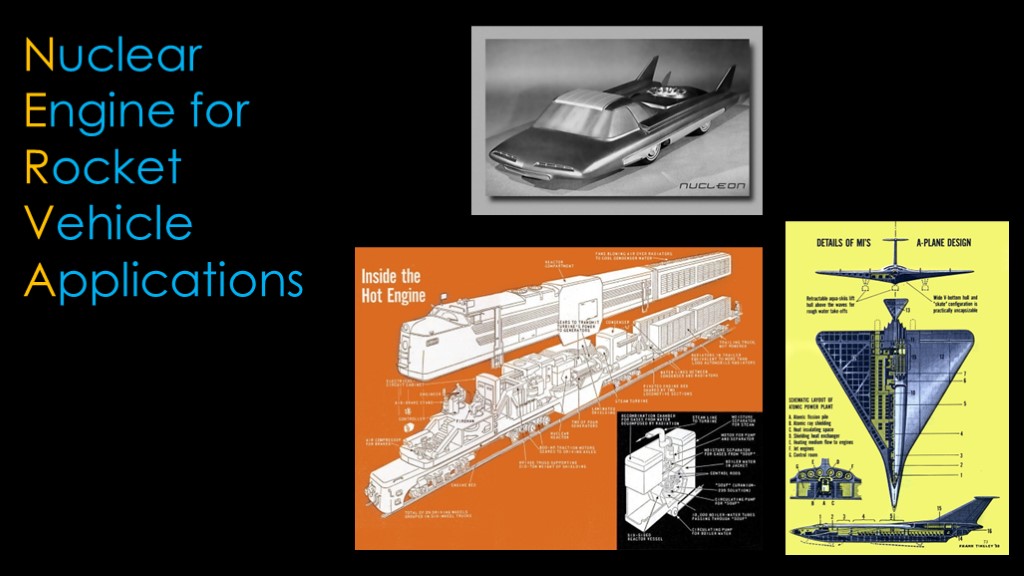
Nerva stands for
Nuclear
Engine for
Rocket
Vehicle
Applications
It came out of the "atomic" 1950s, when there were designs for atomic locomotives, atomic planes, and even atomic cars.
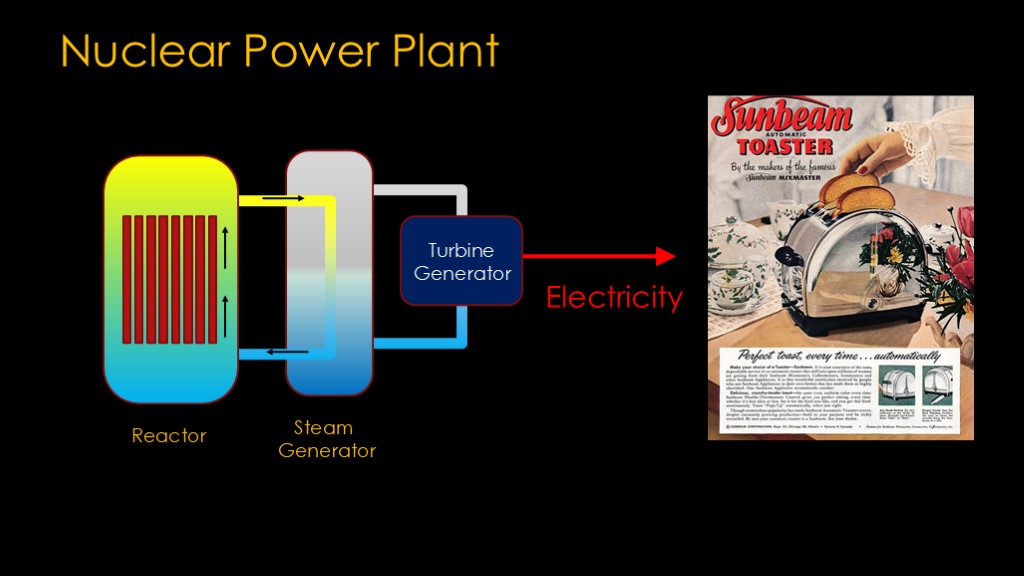
To understand how nerva works, we'll start with nuclear power plants.
In a nuclear power plant, we have a reactor that is used to heat high pressure water.
That water travels into a steam generator where it heats up water to make steam, which is fed to a turbine generator to make electricity, which we use to make toast.
The whole point is to use a nuclear reactor as a heat source.
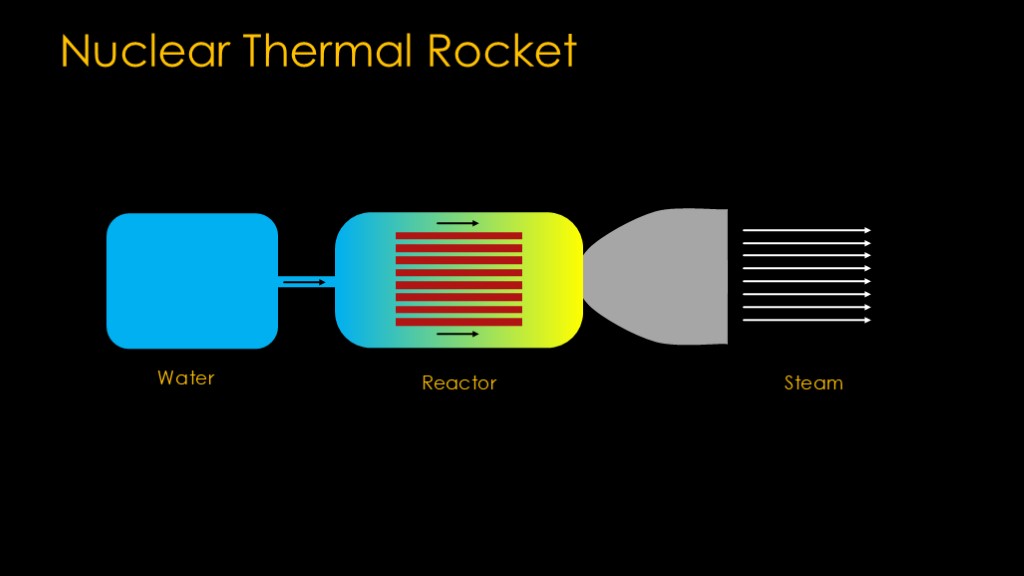
Let's convert that to a nuclear thermal rocket. We'll start with the reactor. We add a water tank to feed water into the reactor, put a rocket nozzle on the outlet, and we get a nice stream of steam coming out the nozzle which gives us thrust.
Unfortunately, it's not a very good rocket, because water molecules are heavy.
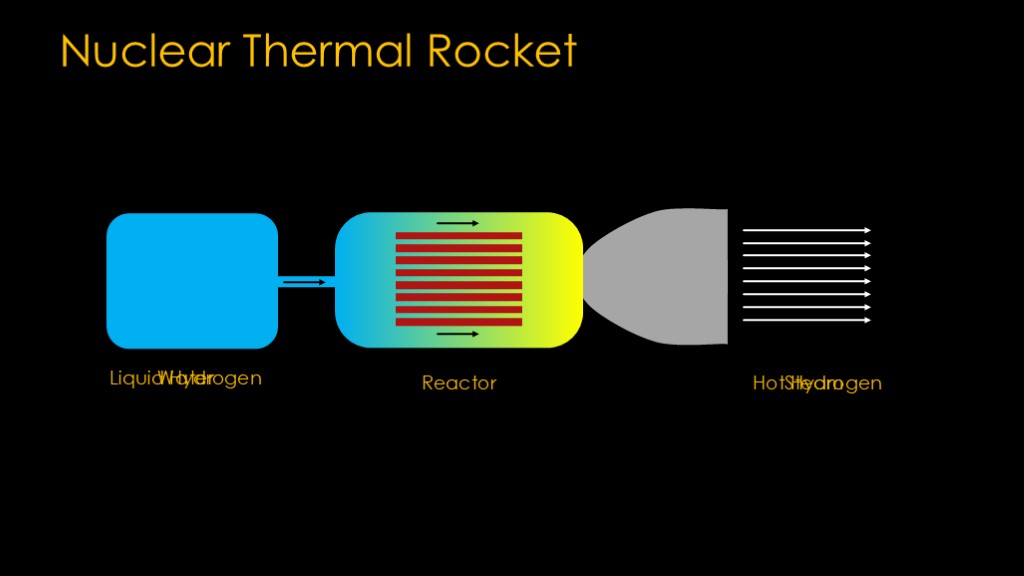
We empty the water tank and fill it with liquid hydrogen as propellant, and we get hot hydrogen out the exhaust. Much better from an efficiency perspective.
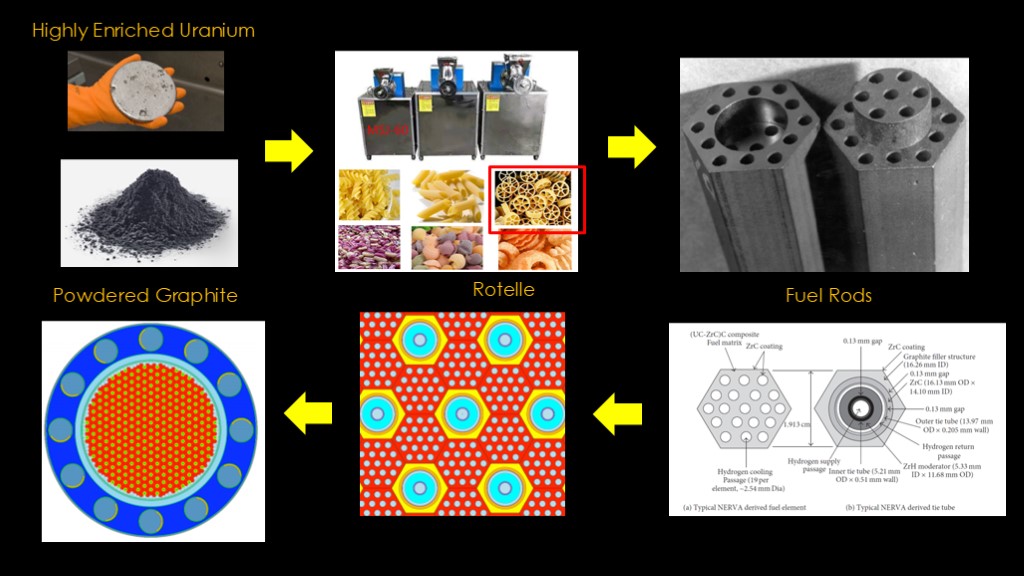
Here's how we make the reactor.
We mix highly enriched uranium and powdered graphite, put it into a pasta machine and use a die like the one used for rotelle, and then extrude out fuel rods with a bunch of holes in them. The hydrogen will flow through these holes and get heated up.
We then plate the fuel rods with Zirconium Carbide to prevent corrosion, and also create similarly sized "tie tubes". These are arranged in a hexagonal pattern and ultimately into a reactor core.
Around the core are a series of control drums; these contain moderators on one side and neutron absorbers on the other side, and rotating them allows the reaction to be controlled.
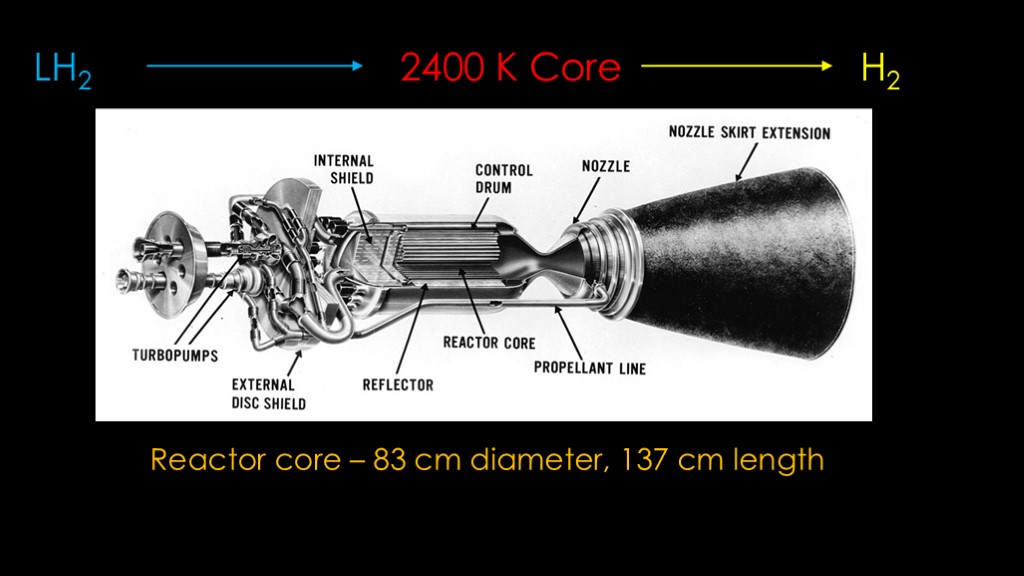
The resulting reactor core - which is around 83 centimeters in diameter and 137 centimeters long - is put into a metal tube, which is similar to the combustion chamber on a chemical rocket.
We now start up the reactor and pump liquid hydrogen into the reactor core, which is running at 2400 Kelvin. The heat vaporizes the liquid hydrogen and it expands and leaves the nozzles very quickly.
Because the exhaust is pure hydrogen and hydrogen is very light, the exhaust velocity is very high and that produces a high specific impulse, or fuel economy - roughly double what is possible with the best chemical rockets.

There are some downsides of nuclear thermal rockets.
The first is that 2400 Kelvin core. Hotter is better in terms of specific impulse, and chemical rockets run at around 3500 Kelvin. Unfortunately, the hotter you run nuclear cores the more likely they are to melt, which means there's a tradeoff between temperature and longevity.
The second downside is their weight. The core itself is quite heavy, and heavy shielding is necessary to shield the rest of the rocket from the radioactivity of the core. Thrust to weight ratio is very important for rocket engine performance and the extra weight generally cancels out the advantage of higher specific impulse.
The third downside is the liquid hydrogen propellant. It takes big and heavy tanks and because it is very cold it is difficult to keep liquid.
Oh, yeah. As soon as you start it up the engine it becomes very radioactive and nobody can get near it without a lot of shielding.
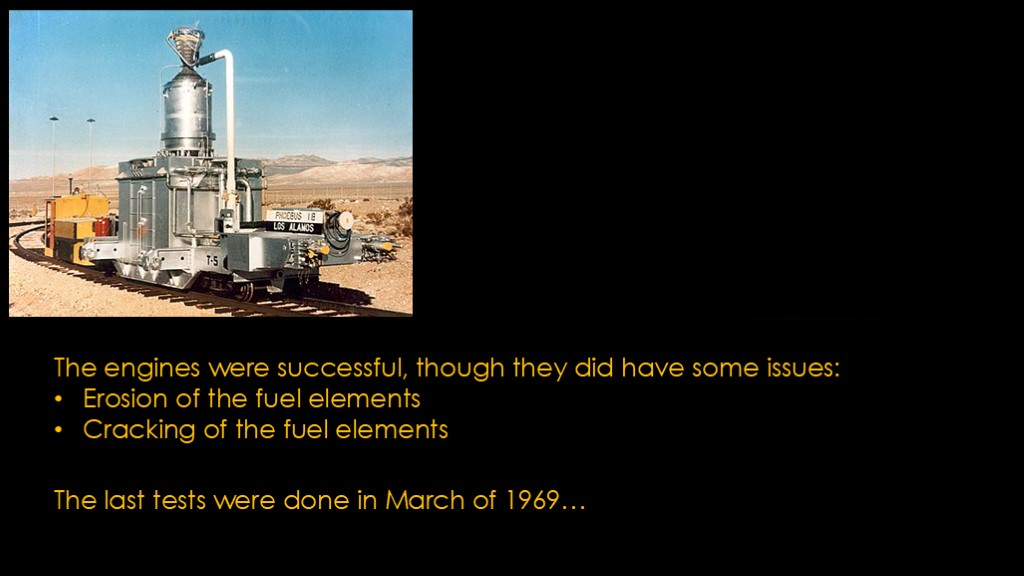
In the 1960s there was an extensive development program for Nuclear Thermal Engines run out of Los Alamos, with a test complex at Jackass Flats in New Mexico.
Test configurations were built onto rail cars which were then moved to remote test cells for testing with the engine exhaust pointed up into the air. This shows the Phoebus 1B engine on its way to testing in 1967
These reactors are highly stressed; this one operated at a heat output of 1500 megawatts, which is perhaps half the output of a nuclear power station.
Though the development work was ultimately successful, they did have ongoing issues with both erosion and cracking of the fuel elements.
Here's a video of one of the tests. And yes, they did just send the exhaust up into the air, sometimes with parts of fuel rods.
The last tests were done in March of 1969.
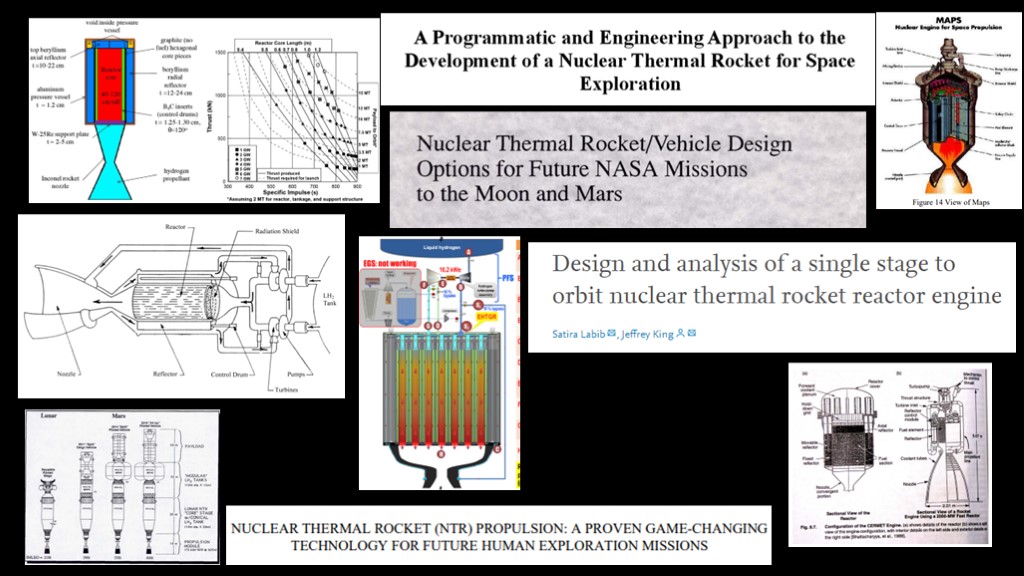
Since NERVA, there has been a lot of further research and design work done on nuclear thermal engines, which, with a few exceptions, has generated lots of paper and very little hardware.
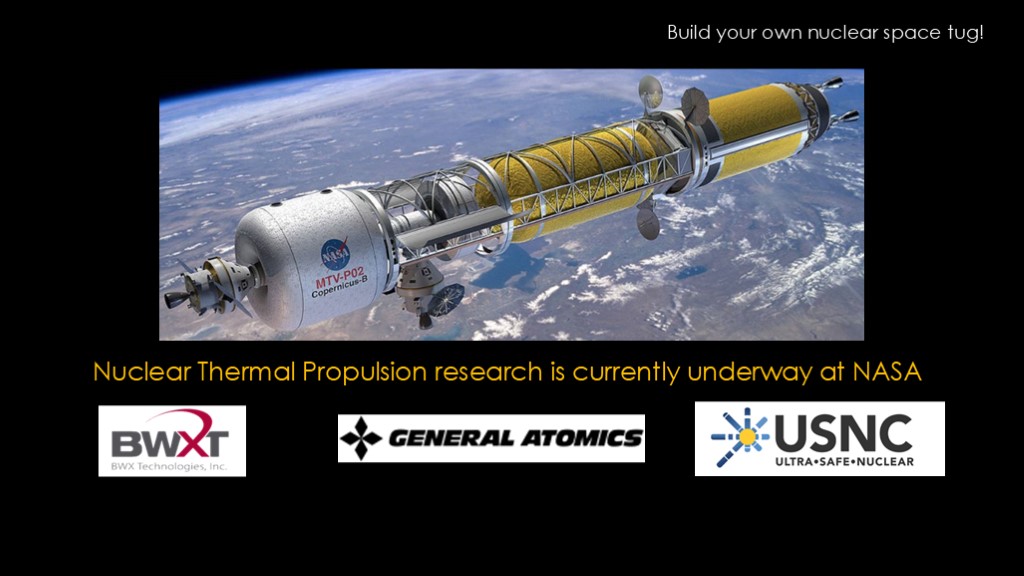
For the last few years, there has been a program at NASA to build an advanced nuclear thermal rocket.
There are small contracts awarded for initial designs for small nuclear thermal engines.
If you want to explore nuclear thermal rockets in more depth, see my video "build your own nuclear space tug!"
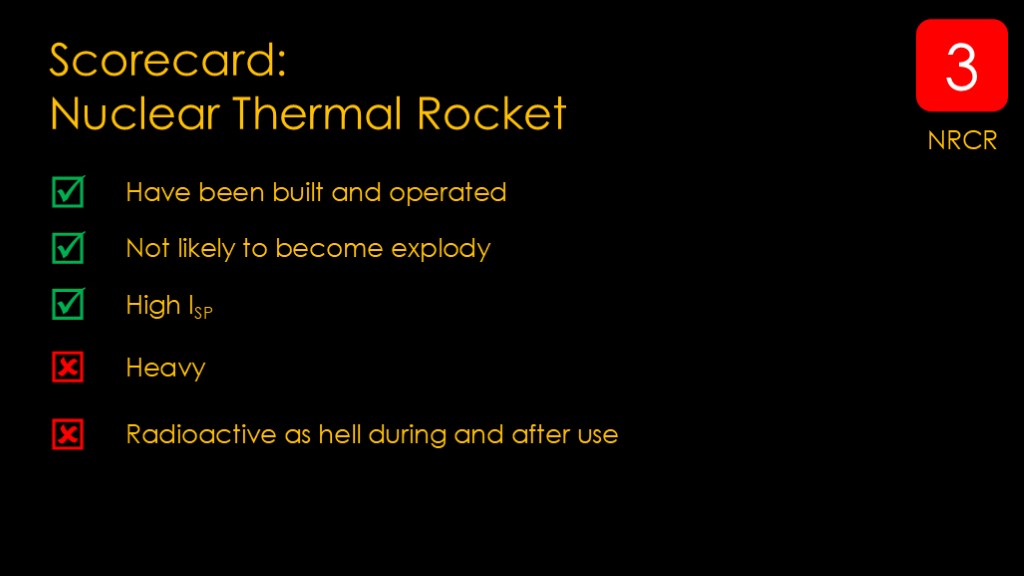
Here's a scorecard for nuclear thermal rockets...
On the plus side, they have been built and operated, they are not likely to become explody, and they have a high specific impulse.
On the negative side, the high specific impulse is negated by the heavy engine and heavy shielding required, and they are radioactive as hell both during and after use.
Overall, I'm going to give them a nuclear rocket craziness rating of 3; I don't think they are a great idea but you can probably build a real engine that generally does what you expect it to do.
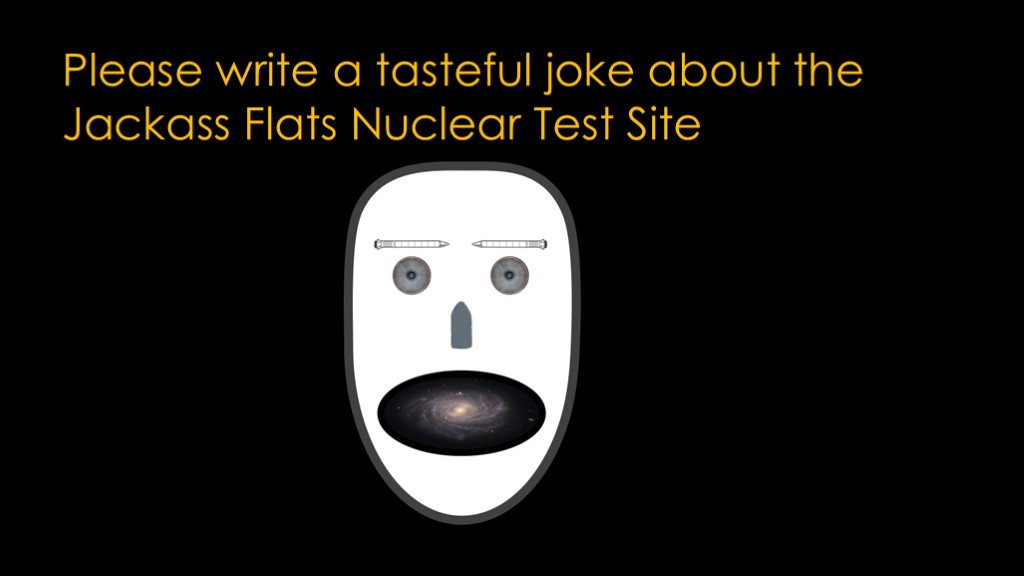
If you enjoyed this video, please write a tasteful joke about the jackass flats nuclear test site.

This is episode 2 of the series on crazy nuclear rocket engines, where we will examine the centrifugal nuclear thermal rocket design.
If you haven't watched it, please watch the introduction video now.
http://local.ans.org/ne/wp-content/uploads/2021/02/OverviewCNTR-ANS-Winter-2020-summary-paper.pdf

We're going to build a nuclear rocket engine based on a carnival ride. The gravitron.
The gravitron has a large drum that spins around.
The rotational force pushes the occupants to the outside and eventually provides enough force to lift them off their feet.

Here's how we build our engine
We build a drum with an axle at the top so that we can spin it around. At a few thousand RPM
Now we can put liquid uranium on the inside of the drum. The force of the spinning drum holds the molten uranium to the wall, and the little lip at the nozzle end keeps the uranium from just slipping out the nozzle.
We can then inject hydrogen into the middle of the reactor, and the hydrogen will... Well, it won't do that much because it's not in contact with the hot liquid uranium. Worse, our drum wants to melt because it doesn't have any cooling.
Hmm....
We add an outer drum and flood the space between it and the inner drum with hydrogen to cool it. And then we drill a bunch of tiny holes in the drum so that the hydrogen can bubble through the molten uranium and get superheated, to 5000 K. Much hotter than the solid core, and therefore giving a specific impulse of about 1500 to 1800.
That sounds great.
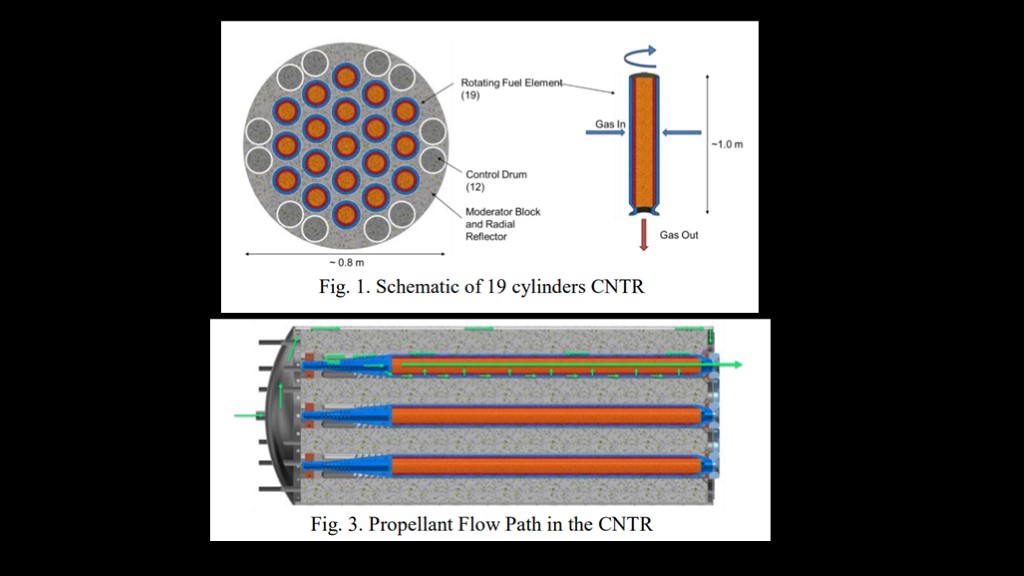
Here's one interpretation of this design. This one use 19 separate rotating cylinders.
https://sci-hub.se/https://arc.aiaa.org/doi/pdf/10.2514/3.28189
https://sci-hub.se/https://arc.aiaa.org/doi/pdf/10.2514/3.2141
http://local.ans.org/ne/wp-content/uploads/2021/02/OverviewCNTR-ANS-Winter-2020-summary-paper.pdf
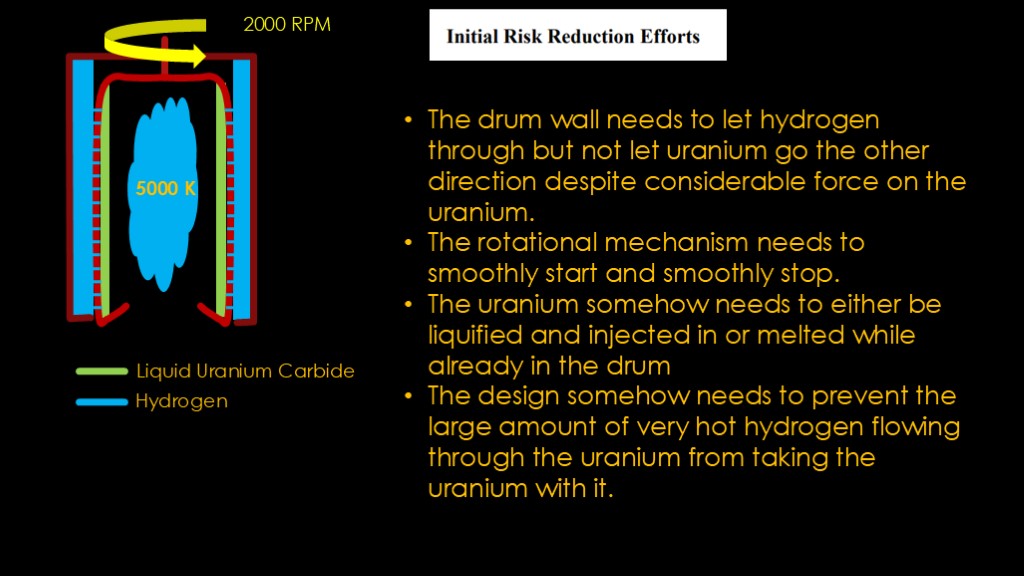
One of the papers on this reactor has a section labelled "Initial Risk Reduction Efforts", which is engineer-speak for "things we don't know how to do that might violate the laws of physics", and I thought that was an appropriate title.
The first problem is the drum. The uranium will have a lot of force trying to push it through the drum wall and yet the drum has to prevent that and let hydrogen go the other way in large volume.
The rotational mechanism will require tight tolerances and needs to be smooth despite being filled with an inherently sloshy load of molten uranium.
Figuring out how the fuel goes from solid to liquid and ends up in the right place will be challenging.
And finally, there is a lot of hydrogen bubbling through the very hot fuel, and that will inevitably cause some uranium to leave the spinning surface, and some of that will be carried out of the reactor by the fast moving hydrogen.
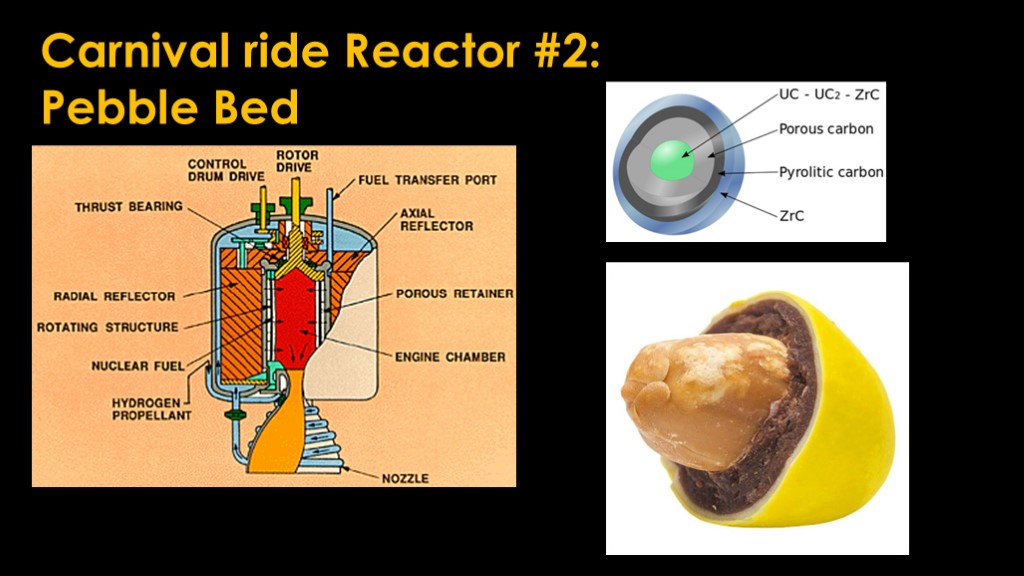
There's a fun variant of this design called the pebble bed, with the same basic architecture but instead of using molten fuel, you use little uranium pebbles.
They're a bit like peanut M&Ms, with the nuclear fuel acting as the peanut, the carbon layers acting as the chocolate, and the zirconium carbide playing the role of the candy coating.
The advantage of pebble beds is that the pebbles are much stronger than the fuel rods and therefore can be run at a higher temperature. Pebble beds have been used in other reactor designs
In the pebble bed engine, you need to spin the engine fast enough that none of the pebbles escape out the nozzle, which seems complicated with a high hydrogen flow, but probably much easier than it is with liquid uranium.
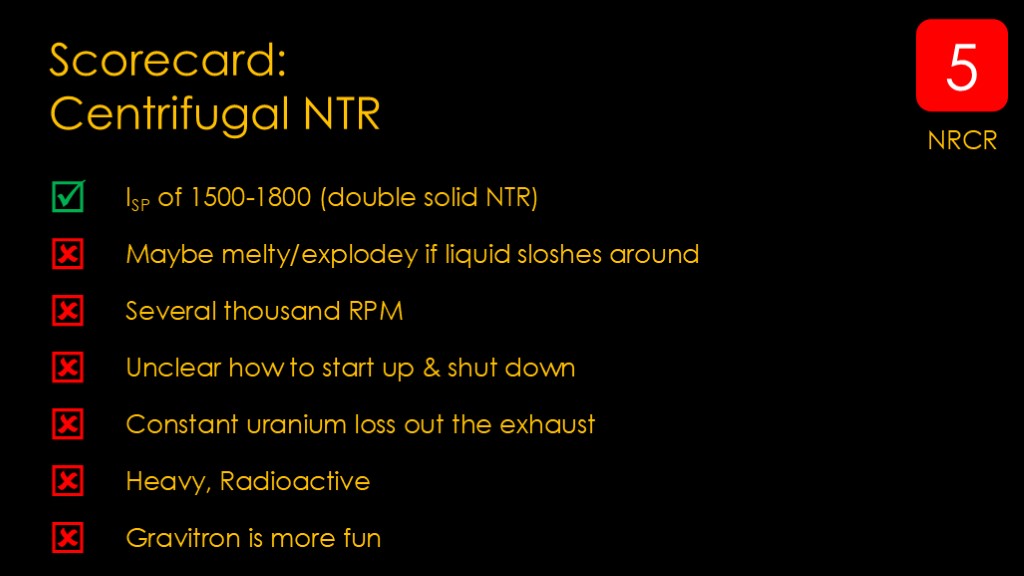
Here's a scorecard for centrifugal nuclear thermal rockets
On the plus side, the liquid version might yield a specific impulse of 1500-1800, or about double a solid nuclear thermal rocket
On the negatives side...
It might become melty or explody if the molten uranium sloshes around rather than staying in a nice smooth layer.
The mechanical design requires a drum rotating at several thousand RPM
It's unclear how to start up and shut down the reactor
There's a potential for constant uranium loss out the exhaust, which not only loses uranium but exposes the crew to more radiation from fission products outside the shielding.
And like other nuclear reactors, it's heavy and it's radioactive.
And finally, gravitor is more fun
I'll give it a 5 for a nuclear rocket craziness rating.
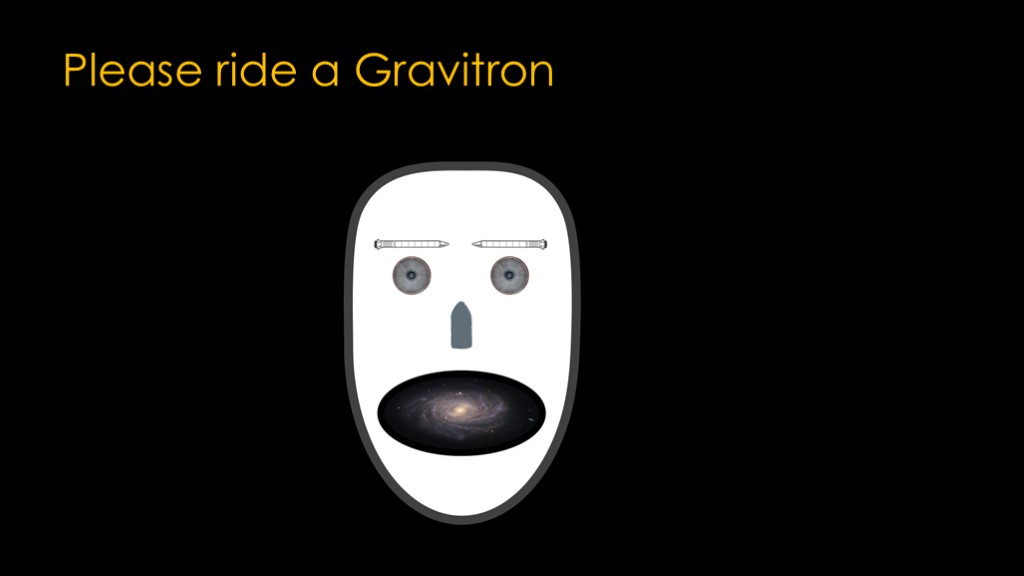
If you enjoyed this video, please find a gravitron and ride it. We will also accept reasonable substitute rides such as gravitor, rotor, or zero gravity.
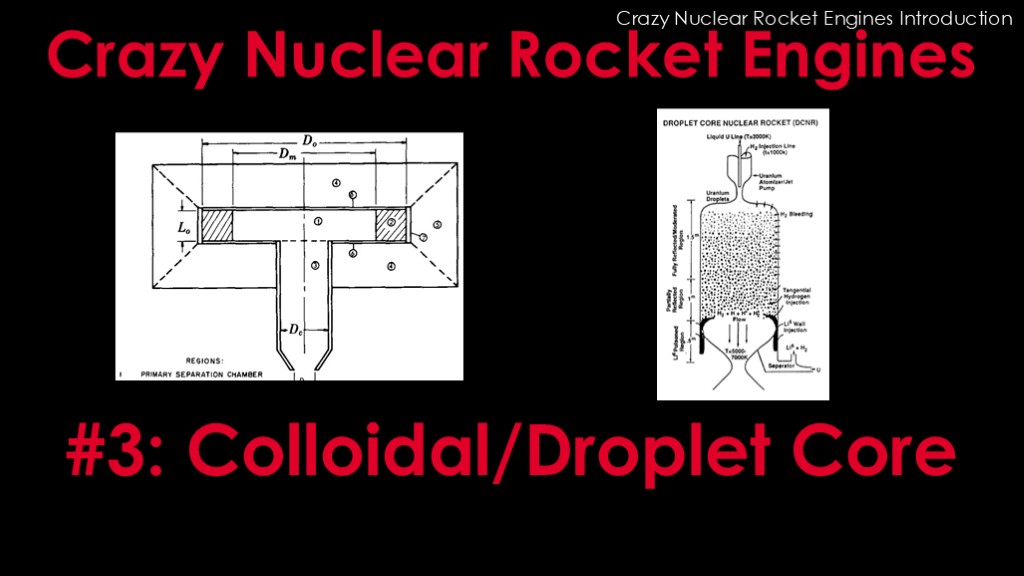
Welcome to episode #3 of the series on crazy nuclear rocket engines, where we will examine the colloidal and droplet core designs.
If you haven't watched it, please watch the introduction video now.
https://patents.google.com/patent/US3711370

Here's how the colloidal core works...
You make a big chamber in the shape of a flat wheel, and then you cut a hole in the bottom of it and attach a rocket nozzle.
From a top view, it looks like this.
You then take your fuel particles - uranium particles coated in zirconium carbide for toughness - and mix them with hydrogen.
That mixture is injected through a specially designed set of nozzles, and the nozzles plus vanes in the chamber create a swirling vortex.
The vortex pushes the uranium particles towards the outside of the chamber, where they fission, and the hydrogen is heated and pushed towards the middle, where it exits through the nozzle, producing thrust.
The carefully-tuned vortex keeps the uranium from exiting - at least most of the uranium. You will probably still lose a few kilograms per minute of operation.
All of that gets you a specific impulse of around 1200.
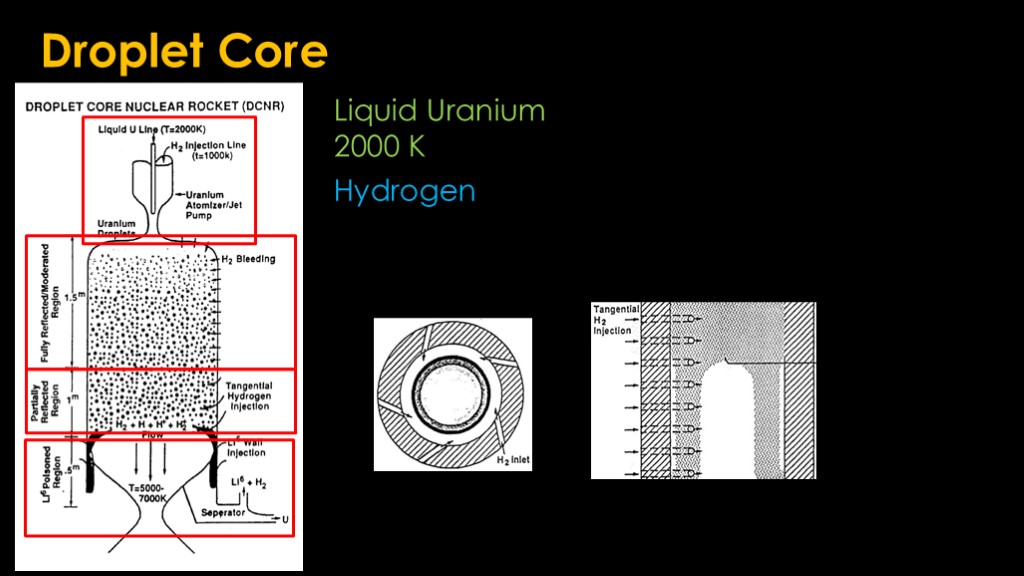
And the droplet core...
Here we take uranium and heat it up to 2000 K (how that is done is left as an exercise to the reader), and then we push it through an atomizer (think perfume mister) so we have a big chamber full of uranium mist. At the same time, we inject hydrogen into the mist.
The top part of the chamber is designed to keep the fission reaction going. We also pump hydrogen in from the side so that the uranium doesn't clump against the walls and melt them. This is where most of the hydrogen heating takes place.
Now we have a problem. Both the hydrogen and the uranium are going to be headed out the nozzle, and we need a way separate the uranium. We use the same approach as in the colloidal reactor, injecting hydrogen so it swirls in the middle of the chamber and pushes the majority of the uranium towards the outside walls.
We now have a lot of extremely hot uranium. We inject liquid lithium in the bottom part of the combustion chamber to cool the uranium down so we can separate it from the lithium for re-use it.

Here's a scorecard for colloidal or droplet cores.
On the plus side, they can generate a decent specific impulse, maybe 1200 to 2000
On the negatives side...
There's a lot of dependence on the power of the vortex to limit the fuel loss, and any uranium or fission fragment loss during operation will increase the radiation on the crew.
Things can easily get melty if the fuel clumps together.
It's not clear how the solid fuel is melted initially
Liquid lithium adds a lot of complexity and we need a lithium/uranium separator
And finally, it's heavy and radioactive.
It gets a solid 5 on the craziness score. I think you can build it, but I also think it will simultaneously melt down and send most of the uranium out the nozzle.

If you enjoyed this video, please eat some jello with blueberries in it.

Welcome to Crazy Nuclear Rocket Engines Episode #4: Pulsed Solid Core
If you haven't watched the introduction video, please do that now.
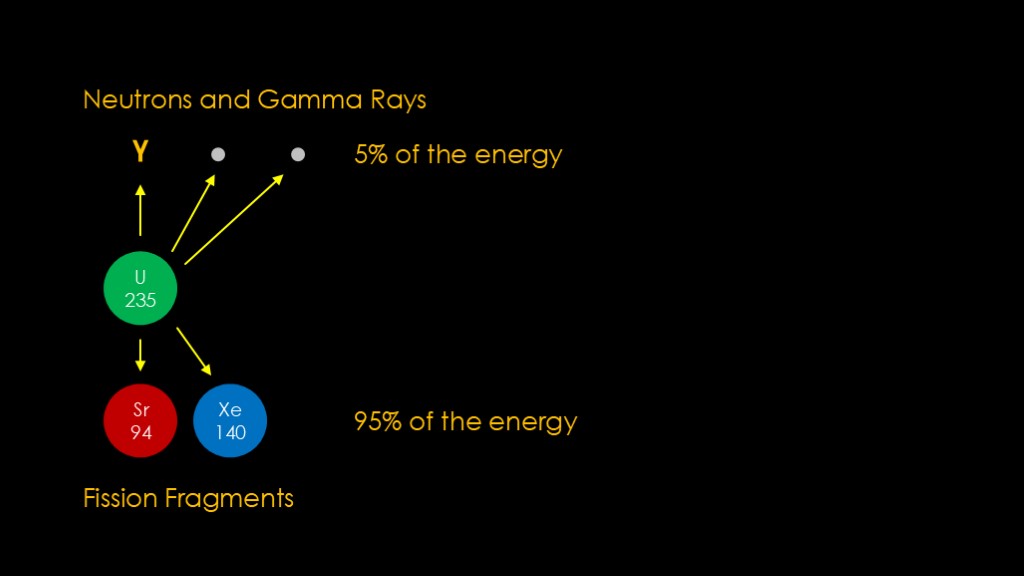
Expanding on the fission discussion in the introduction, when a uranium 235 atom splits, the are multiple products.
First, there are fission fragments, the new atoms that are made up from most of the mass of the uranium atom.
Second, there are fast moving neutrons that used to be part of the uranium atom and a high-energy gamma ray.
The fission fragments are moving very fast and therefore contain 95% of the energy that is created. That motion - or heat - is what heats up the nuclear core, and - if we get too much of it - what melts the nuclear core.
The neutrons and gamma rays contain 5% of the energy that is created, but it is energy that can travel outside the solid core.
The goal of the pulsed solid core is to harness that 5% to superheat the hydrogen to a higher temperature than the general temperature of the core.
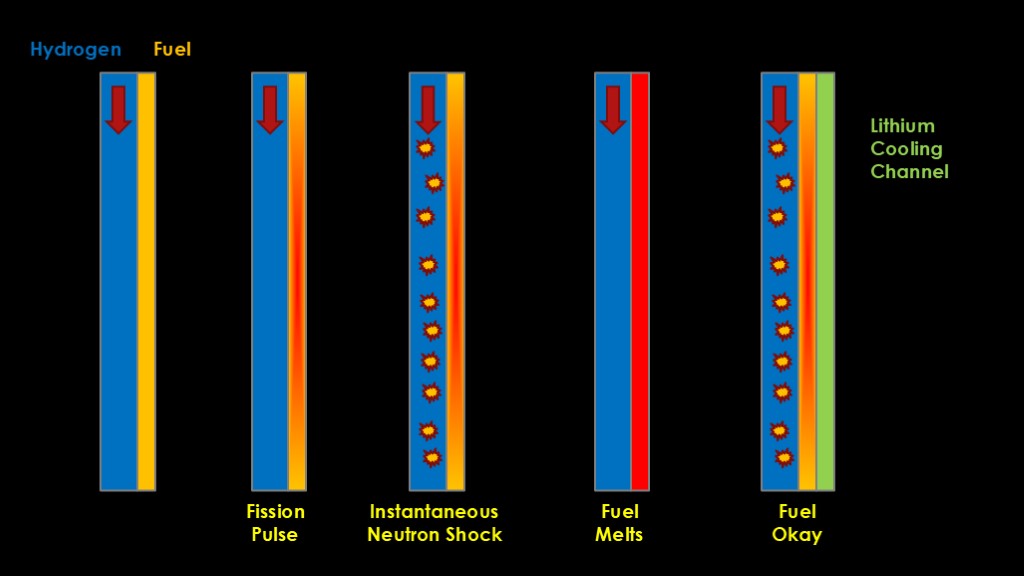
We start with a hydrogen channel that is right next to a thin vertical channel of uranium fuel.
We then use external means to increase the reactivity of the fuel, so it goes from very little fission to a large amount of fission quickly.
This generates a large pulse of neutrons, which travel into the hydrogen fuel and heat it up very quickly. Because we are heating by neutrons, we don't have the temperature limits that we had in the solid core design, so we can end up with much hotter hydrogen and therefore a higher exhaust velocity and specific impulse
Immediately after that pulse, the resulting heat pulse melts the fuel, destroying the engine. Which would seem to be a disadvantage.
However, what if we could put something next to the fuel to suck all the heat away, so that it wouldn't melt. It turns out that to conduct the heat away quickly enough, you need a material that is really good at conducting heat and has a reasonable melting point, so liquid lithium metal is the coolant of choice. The core sits idle until the lithium has pulled enough heat out of the fuel so it can survive another pulse.
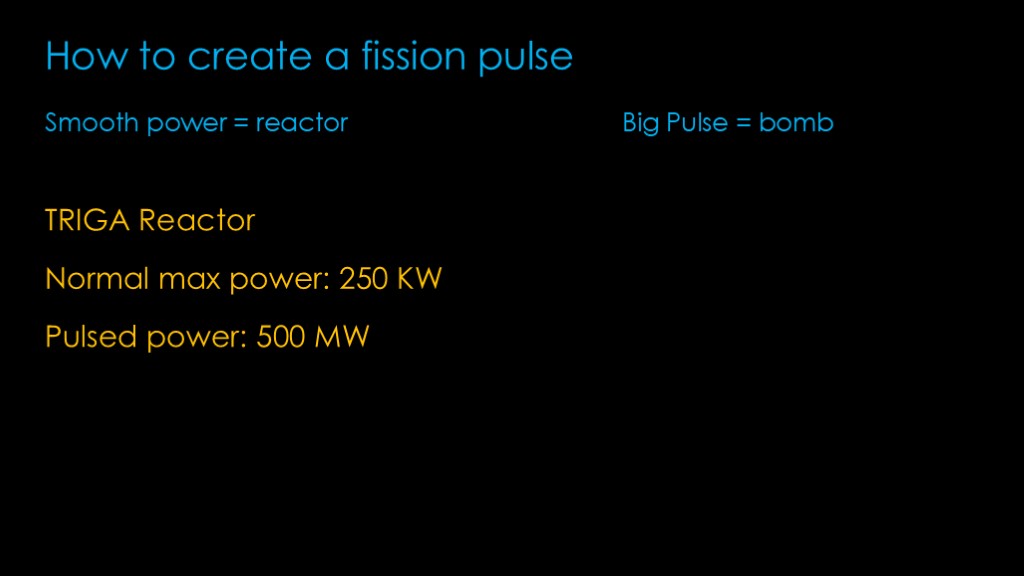
But how to create that fission pulse?
Generally speaking, the goal with a reactor is to slowly and smoothly increase the power of the reactor. If we end up with a big pulse of fission, that is generally a bad thing - less like a reactor and more like a bomb.
Interestingly, this is a solved problem.
There is a research reactor design known as TRIGA that is used at many universities. Normally, it's max power is only 250 KW and it typically runs at much lower power levels, but it can also operate in a pulsed mode.
This is a video of TRIGA operating in pulsed mode. Watch for the blue flash.
That blue flash is known as Cherenkov radiation, and it's directly a result of the fission pulse. This pulse was 500 megawatts, or 2000 times the normal maximum output. The loud noise is a control rod being removed or replaced in the core very quickly.
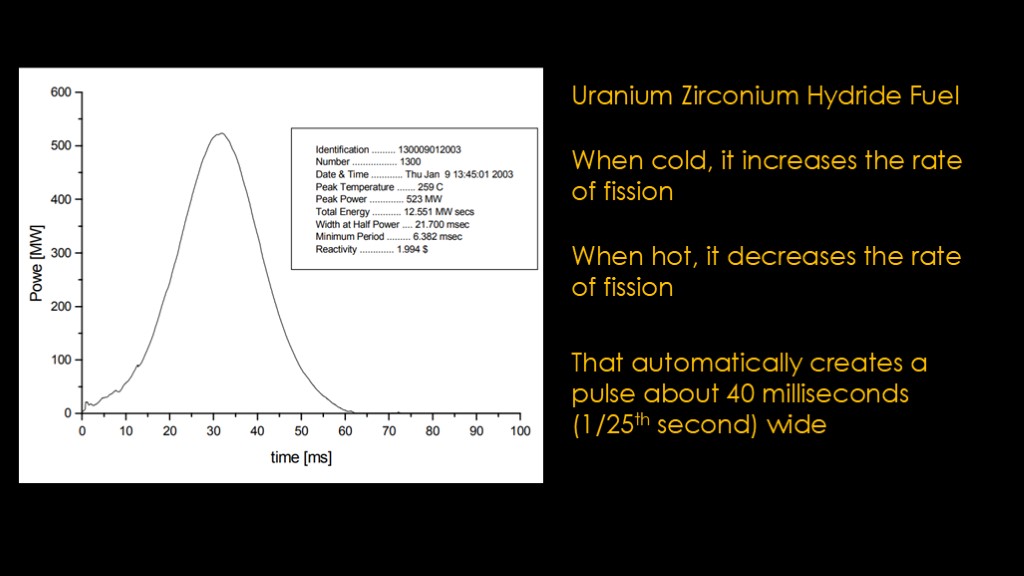
TRIGA accomplishes this by using a very specific Uranium Zirconium Hydride fuel.
When this fuel is cold, it increases the rate of fission
When it gets hot, it decreases the rate of fission.
That automatically creates a pulse about 40 milliseconds, or 1/25th of a second wide.
Triga pulse
https://ansn.iaea.org/Common/documents/Training/TRIGA%20Reactors%20(Safety%20and%20Technology)/pdf/chapter1.pdf
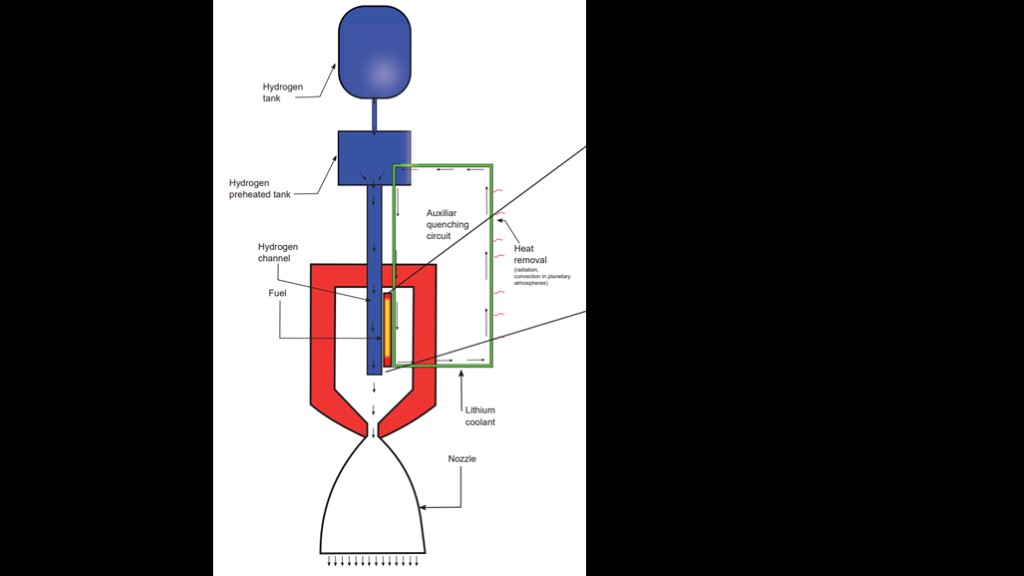
Here's a diagram of the overall propulsion system, which is just like a standard nuclear thermal rocket except for the lithium coolant loop to take the excess heat away.
There's a neat little trick to use some of the heat from the lithium to preheat the hydrogen before it goes into the reactor.
https://sci-hub.se/https://arc.aiaa.org/doi/pdf/10.2514/6.2016-4685
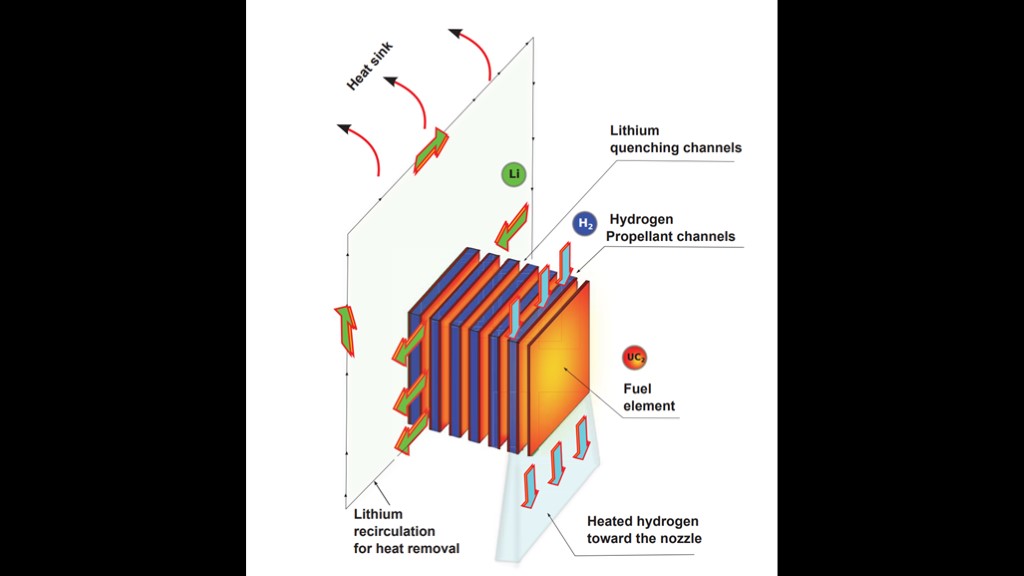
To get sufficient thrust out of this approach the core is arranged as a stack of flat plates of fuel with channels for the hydrogen propellant and the lithium coolant.
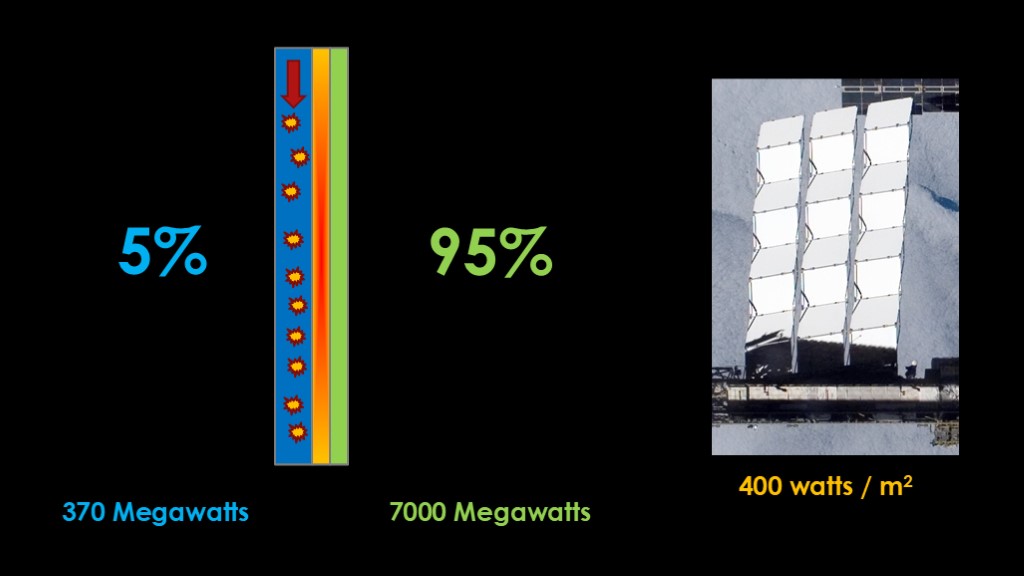
Let's talk about heat and power.
A smallish nuclear thermal rocket engine has a thermal power of about 370 megawatts. That suffices to give roughly the thrust of an RL-10 rocket engine.
That energy needs to come from the 5% of the fission energy that goes to neutrons and gamma rays.
The lithium cooling loop therefore needs to deal with 95% of the fission energy, or 7000 megawatts.
It's not quite that bad because we can use the hot lithium to preheat the hydrogen, but any energy we want to use to go above the non-melting core temperature can only come from the 5%.
That waste heat needs to be radiated away. Current satellite radiators - such as these on the international space station - can radiate about 400 watts per square meter.
7000 million divided by 400 is equal to 17 million square meters of radiator.
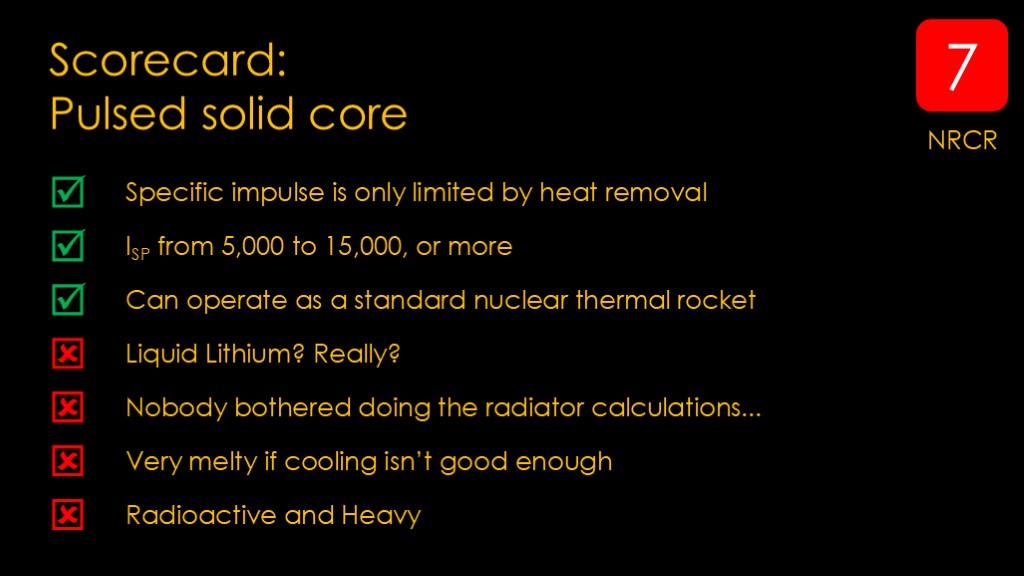
Here's a scorecard for the pulsed solid core
On the plus side:
The specific impulse is only limited by the ability to remove heat, and might reach 5,000 to 15,000, or perhaps more
It can operate as a standard nuclear thermal rocket.
On the downside:
Liquid metal coolants are very heavy, and you need to be able to liquify all of it at startup. You probably need a dual-loop system.
Heat isn't much of a problem in the standard nuclear thermal reactor because it mostly goes into the hydrogen propellant. Here you need to be able to get rid of 19 times the heat that goes into the propellant. It's simply not feasible.
If the cooling doesn't work exactly right, you end up with molten lithium, hydrogen, and very hot uranium mixing together. That has "core explosion" written all over it, and while it's not a nuclear explosion, it's not going to be kind to the rocket engine.
And, as usual, it's radioactive and heavy, especially heavy because of the lithium cooling loop.
I give this design a Nuclear Rocket Craziness Rating of 7.
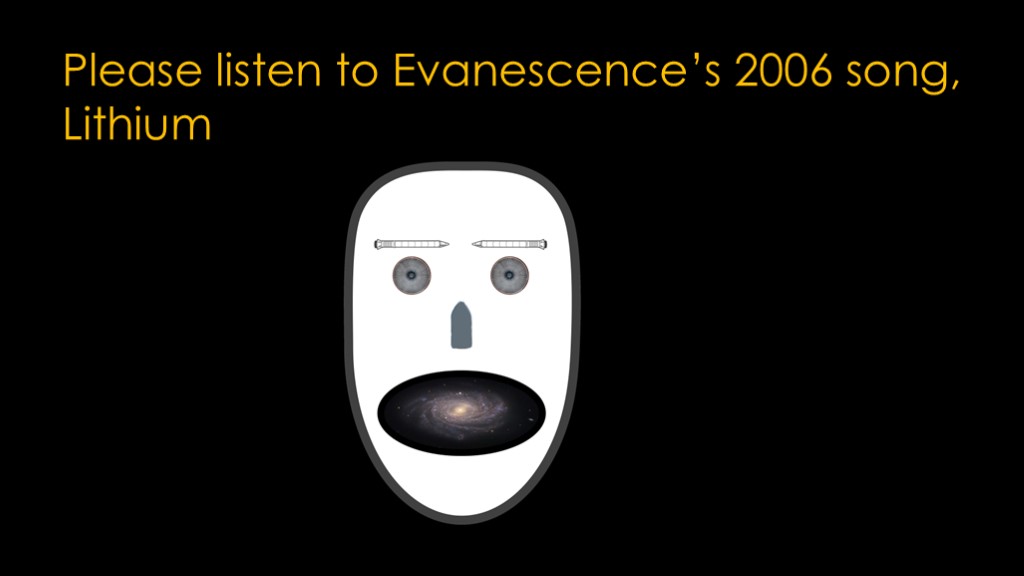
If you enjoyed this video, please listen to Amy Lee's haunting vocals on evanescense's 2006 song, Lithium
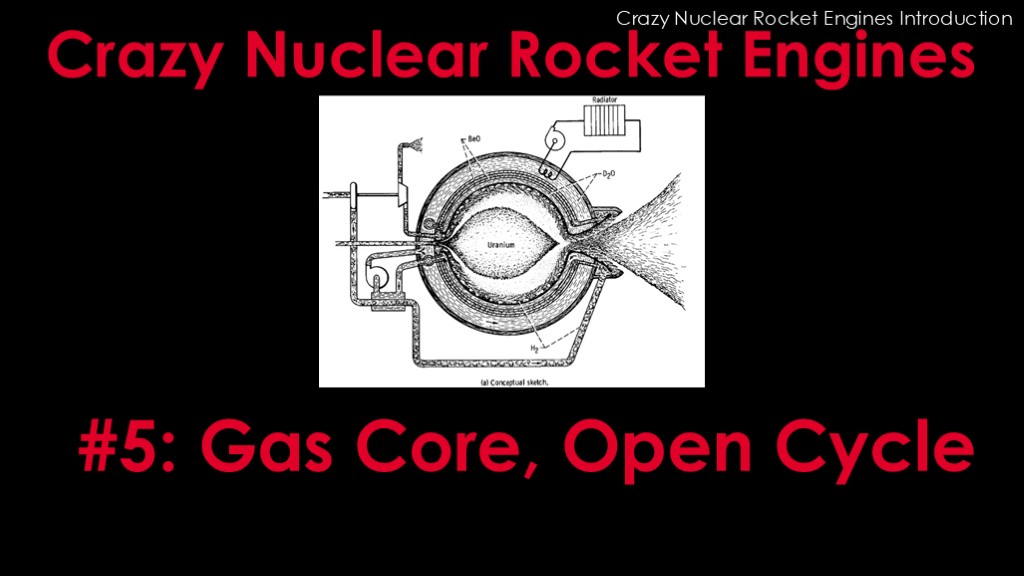
This is episode 5 of the series on crazy nuclear rocket engines, where we will explore the gas core, open cycle design.
If you haven't watched it, please watch the introduction video now.
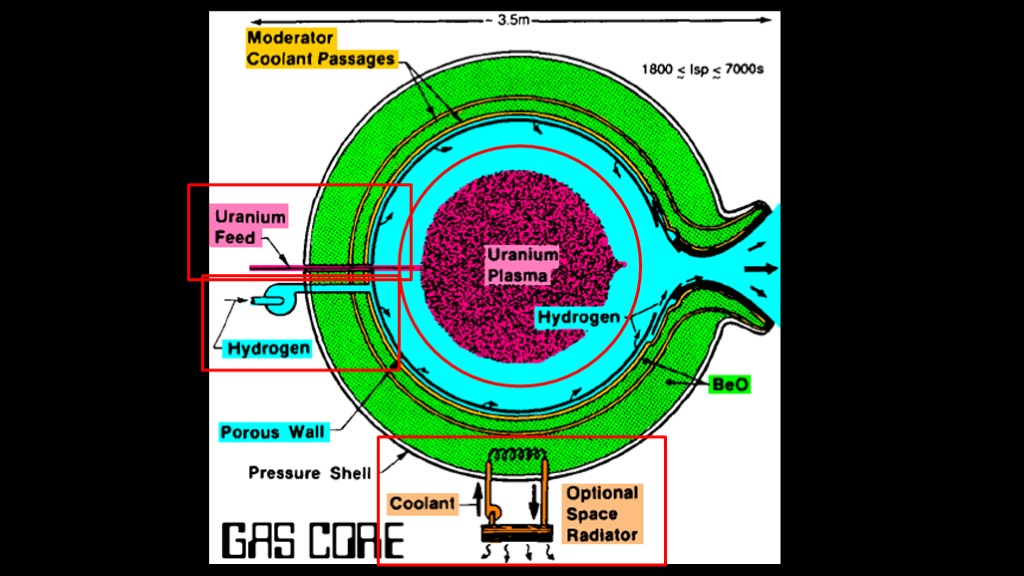
Rather than spend engineering effort trying to keep our reactor core cool, let's let it get as hot as it wants.
Conceptually, it's fairly simple; you have something like a combustion chamber that you inject uranium hexafluoride into, and it starts fissioning and creates a uranium plasma, which may reach temperatures of 50,000 K. That is not a misprint.
It heats up the hydrogen that is being pumped into the chamber (along with Tungsten to improve the heat transfer), and the now very hot hydrogen exits the chamber through the rocket nozzle. As does some of the uranium.
One of the problems is that about 5% of the energy is neutrons and gamma rays, and they heat up the combustion chamber. That can be cooled with hydrogen but it limits your power and therefore your specific impulse to 2000-3000. If you want higher specific impulse, you need a radiator system to pull that heat out of the chamber. That will get you to an Isp of 7000 - 10,000.
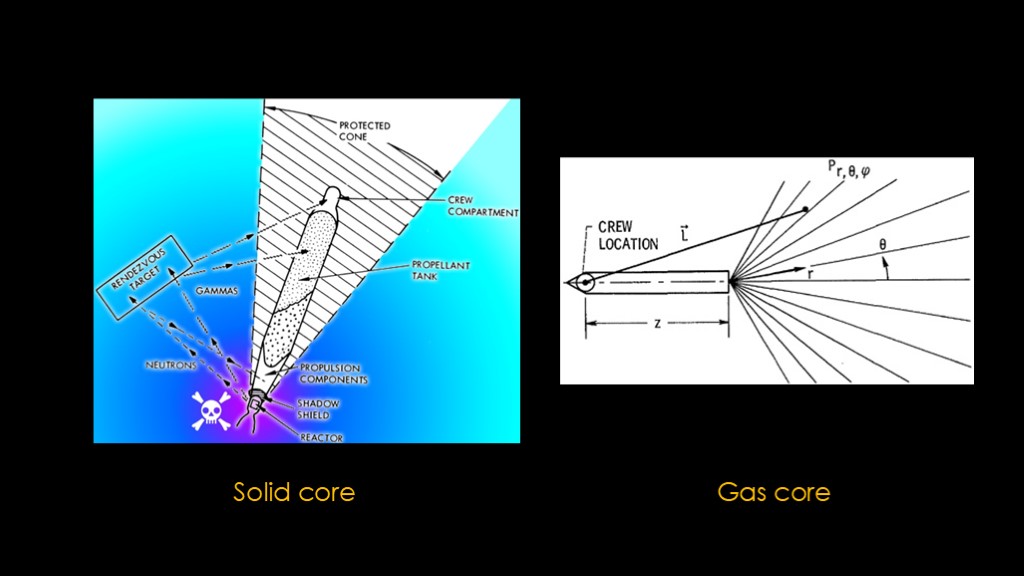
There is a small matter of radiation...
The core in solid core nuclear rockets emits radiation in all directions, but it is possible to use a shadow shield to absorb most of the radiation, and anything in the shadow - such as the crew compartment - receives much less radiation.
In the open gas core you have still-fissioning nuclear fuel exiting through the nozzle and spreading out, and that fuel is emitting a lot of radiation. It's unfortunately outside the shadow and therefore irradiates the crew location directly.
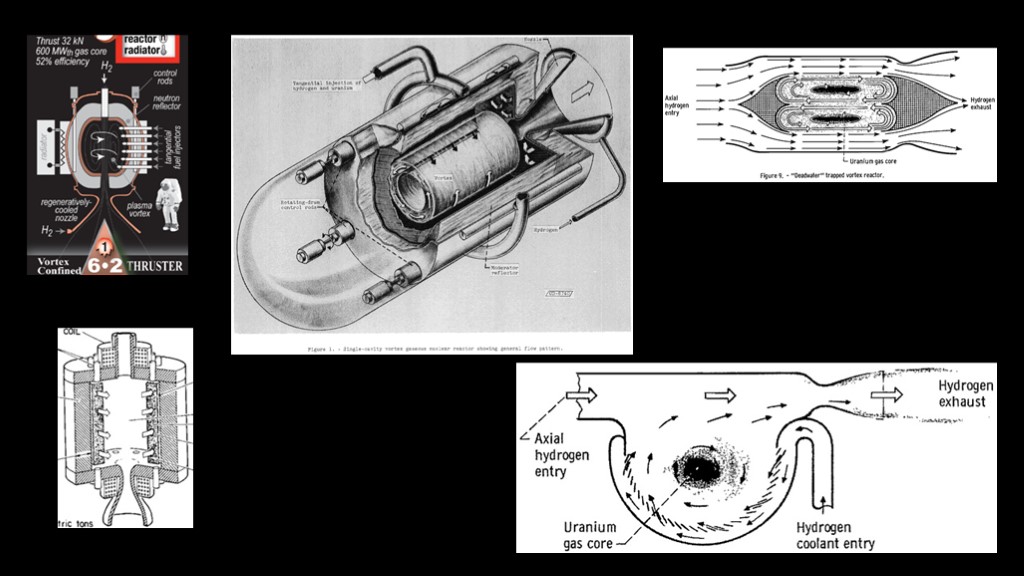
There are many ideas on how to reduce the amount of uranium lost out the nozzle, pretty much all of which involve vortexes.
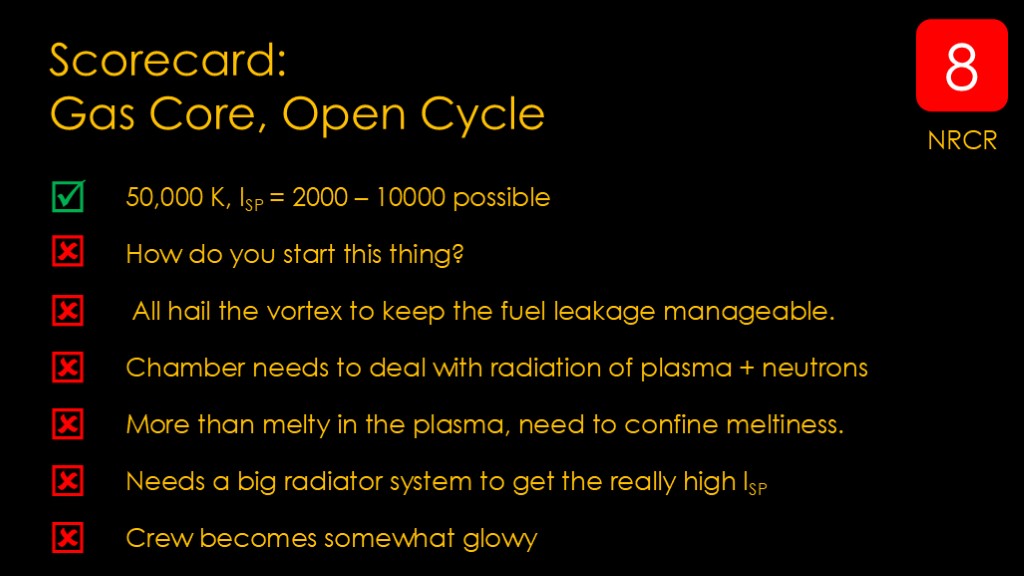
Here's a scorecard for the gas core open cycle engine
On the plus side, the core is very hot and can generate a specific impulse of 2000 to even 10,000
On the negatives side...
How do you create the uranium plasma that starts the thing?
There's a lot of dependence on the power of the vortex to keep the uranium from existing through the nozzle.
The chamber needs to deal with a large amount of radiation + neutrons, and it will be challenging to control the meltiness.
It needs a big radiator system to get the high specific impulse
And the crew will likely becomes somewhat glowy.
It gets a solid 8 on the craziness score.

If you enjoyed this video, please invest in global nuclear fuel, LLC.

This is episode 6 of the series on crazy nuclear rocket engines, where we will examine the nuclear light bulb, otherwise known as the gaseous core closed cycle engine.
If you haven't watched it, please watch the introduction video now.
https://ntrs.nasa.gov/citations/19920001892
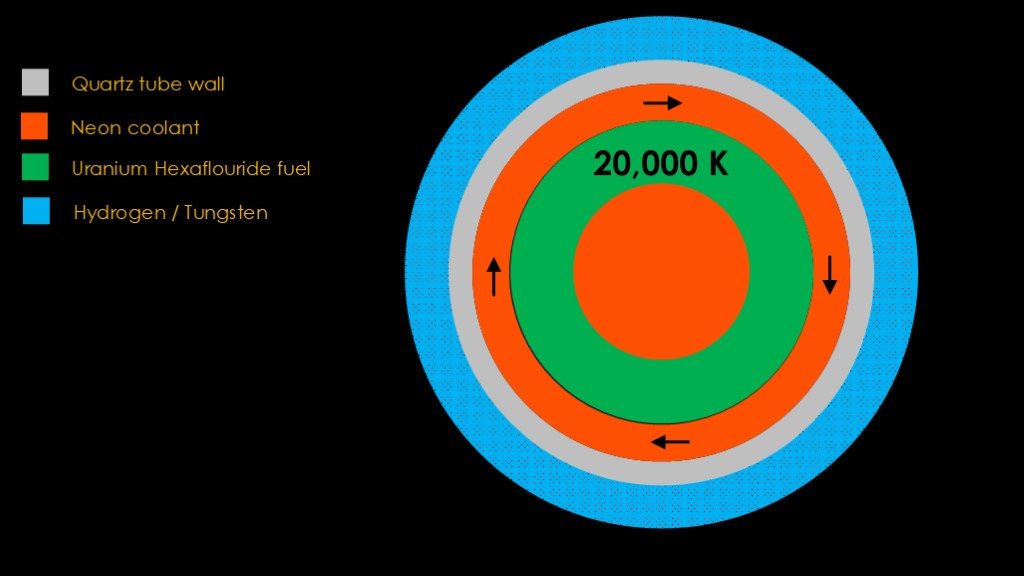
Here's how we build our light bulb...
Start with a bunch of very thin quartz tubes that wrap around in a circle. That is the outer wall of the "light bulb", and it is cooled by running gas through it.
Inside that is a layer of neon gas, injected so it will swirl around the inside of the chamber in a - you guessed it - in a vortex.
And inside that is our fuel, uranium hexafluoride gas, with more neon inside of that.
That gives you a *very* hot gas nuclear core that puts out a ridiculous amount of radiation, hence the "light bulb" term.
Outside of that goes a jacket of hydrogen propellant. Unfortunately, the hydrogen doesn't readily absorb the radiation that the light bulb puts out, so you need to add some Tungsten to heat up and transfer its heat to the hydrogen.
The goal is to be able to run the core at temperatures up to 20,000 K.
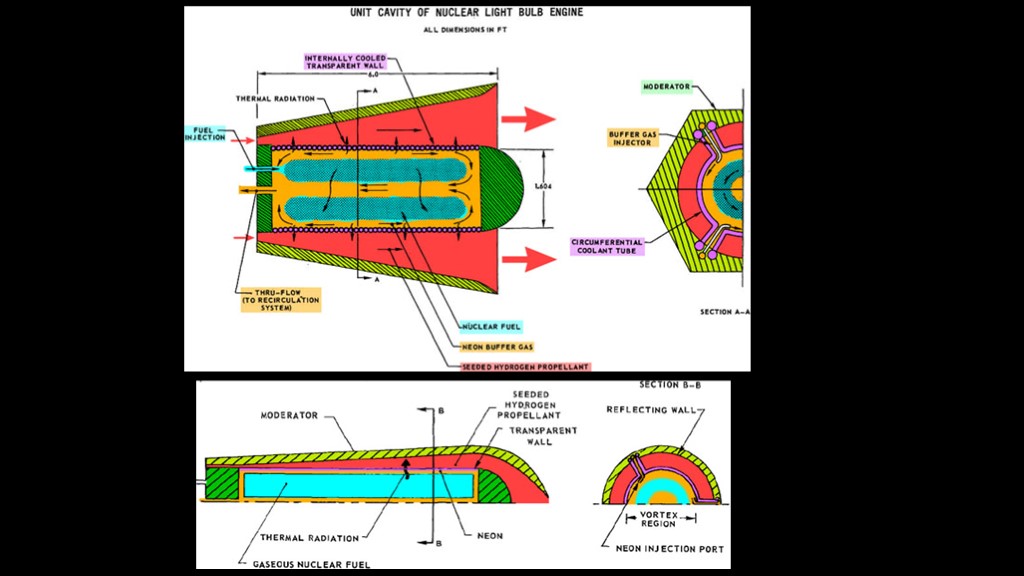
Here are two drawings that make it a bit clearer. The uranium hexafluoride fuel and hydrogen are injected from the left, and the hydrogen exits to the right.
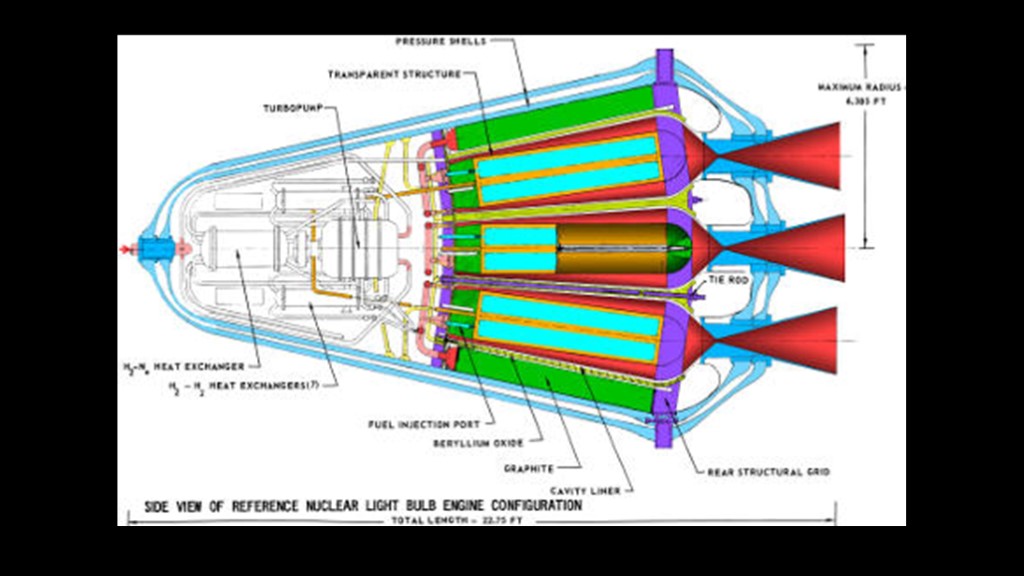
In the vehicle, you put 7 of the bulbs together.
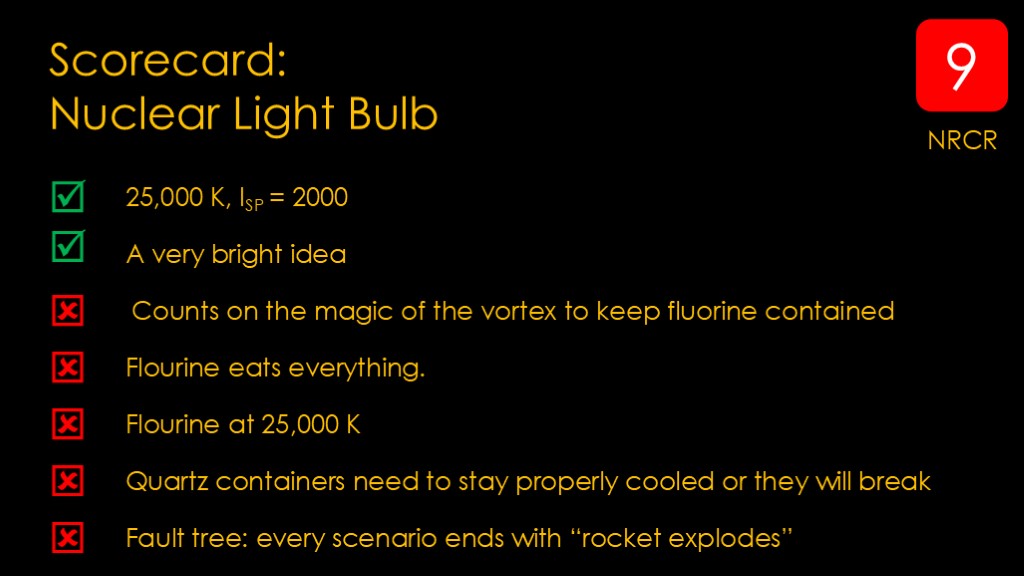
Here's a scorecard for the nuclear light bulb
On the plus side, they can generate a decent specific impulse of around 2000, and the nuclear light bulb is a very bright idea.
On the negatives side...
There's a lot of dependence on the power of the vortex to keep the fluorine contained.
Flourine eats everything. Here's a quote:
Readily capable of detonation or explosive decomposition or explosive reaction at normal temperatures or pressures. Reacts violently with water.
Flourine at 25,000 K is unbelievably reactive.
The quartz containers are fragile and need lots of cooling or they will break.
If you look at the fault tree, every scenario ends with "rocket explodes".
It gets a solid 9 on the craziness score.

If you enjoyed this video, please visit the closest lighthouse.
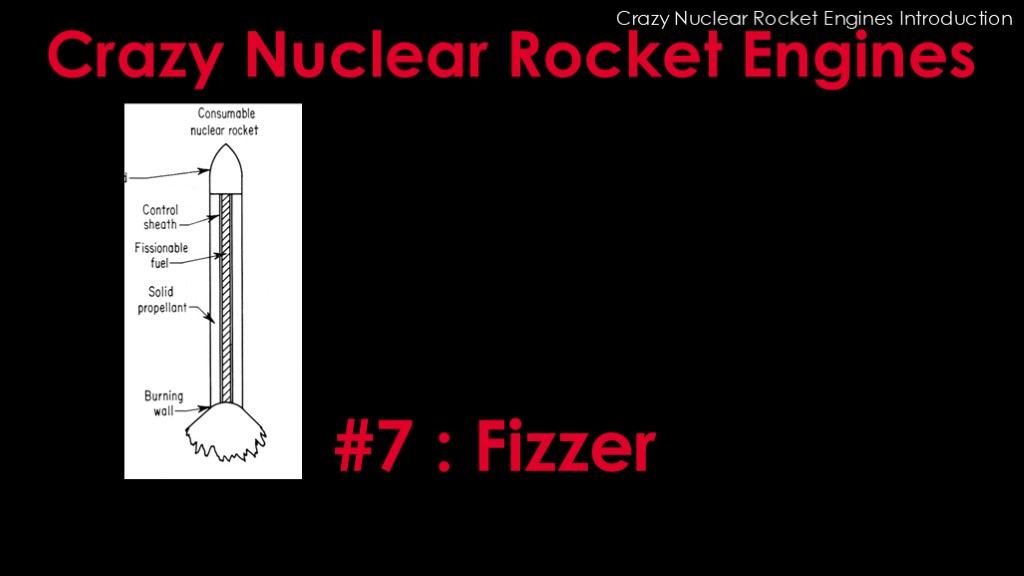
This is episode 7 of the series on crazy nuclear rocket engines, where we will explore the fizzer.
If you haven't watched the introductory video, please watch it now.
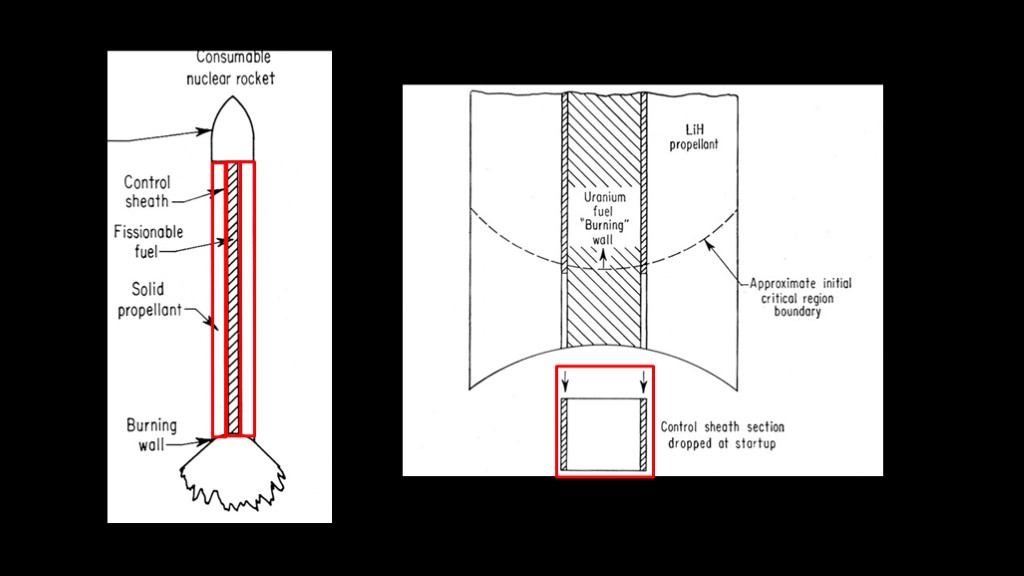
The fizzer is pretty simple.
We start with a long tube like a solid rocket motor.
There is a long rod of uranium 235 running down the middle of the rocket with a cadmium coating on the outside, just enough to keep it from going critical.
Outside the rod is the lithium hydride propellant.
To start the reaction, you drop off a section of the cadmium control sheath at the bottom, and that allows the bottom section of the uranium rod to start fissioning wildly. It heats up the lithium hydroxide so it turns to gas, and an exhaust of lithium, hydrogen, and uranium comes out the bottom of the rocket. The high neutron flux from the burning part continues the process going up the uranium rod.
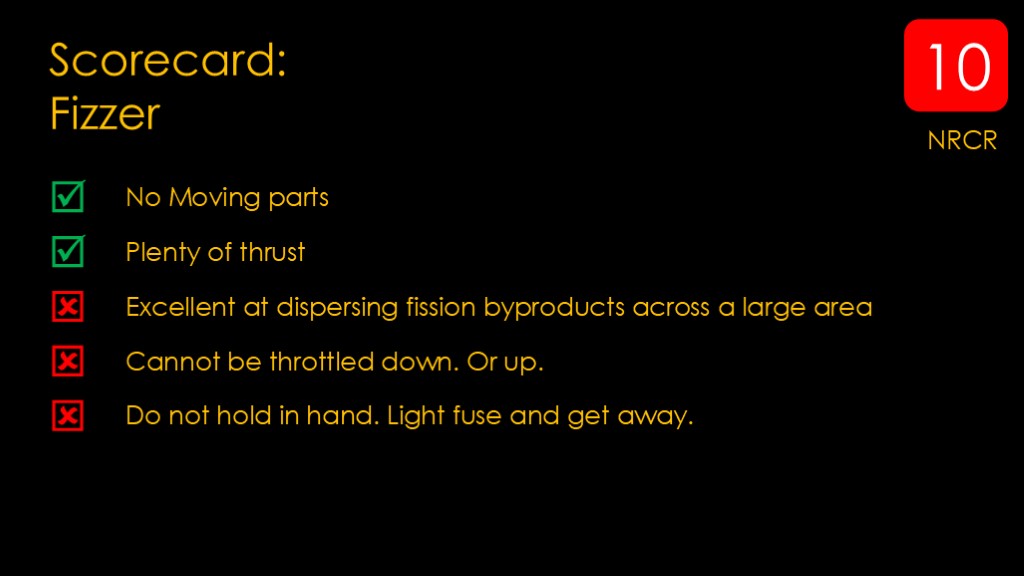
Here's a scorecard for the fizzer
On the plus side...
There are no moving parts, and the design gives you plenty of thrust.
On the negatives side...
It's excellent and dispersing fission byproducts across a large area
It cannot be throttled down. Or up.
Do not hold in had. Light fuse and get away
It gets a solid 10 on the craziness score.
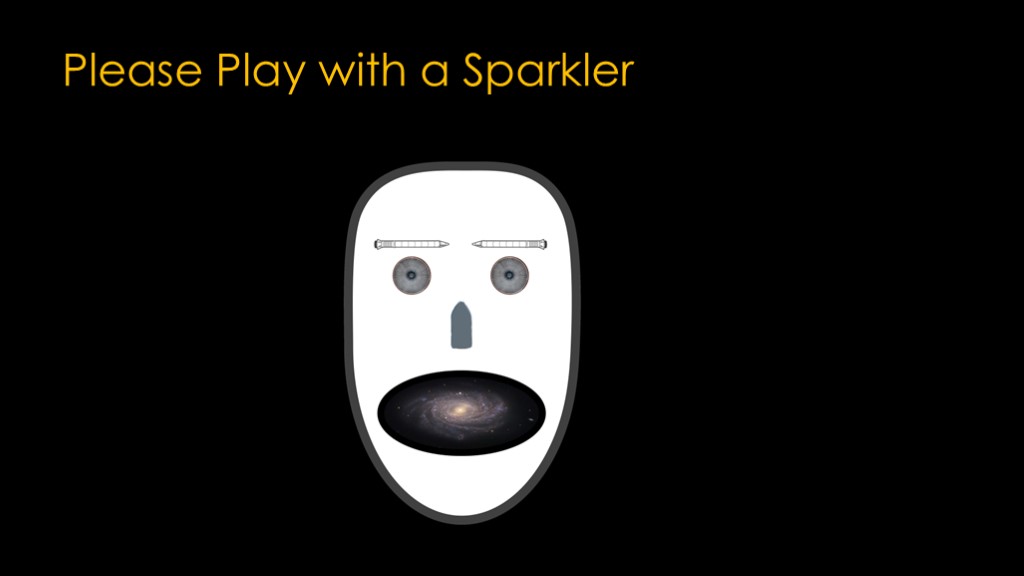
If you enjoyed this video, please play with a sparkler.
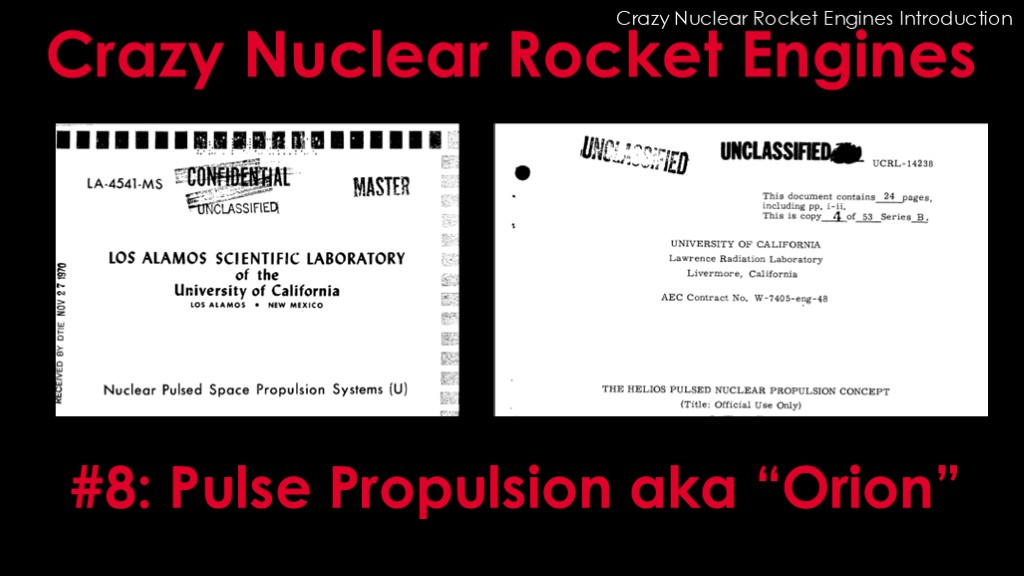
Welcome to crazy nuclear rocket engines #8 - pulse propulsion, otherwise known as "orion".
Which is a great example of the old saying "If all you have is a hammer, everything looks like a nail".
I've included the title pages of two different documents that explore this concept, just to show that it wasn't just a crazy idea somebody came up with, it was a crazy idea that many people researched and discussed seriously.
This would be a great time to watch the introduction if you haven't already.
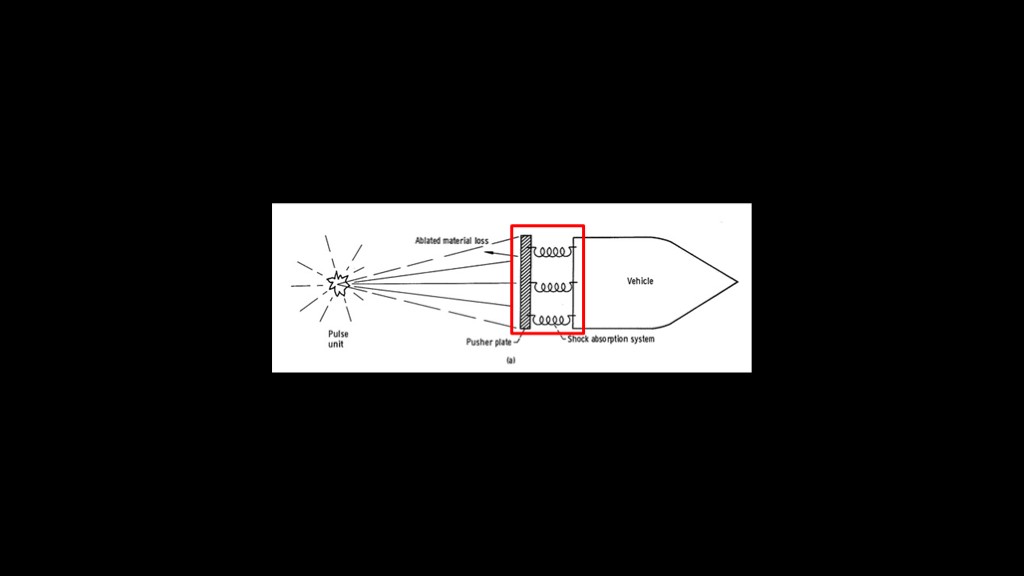
The concept is pretty simple.
You take whatever vehicle you want to move, and at the bottom you attach a big flat pusher plate, connecting it to the vehicle with some big shock absorbers.
Then you set off a series of explosions near the pusher plate, and the shock wave from the explosion hits the pusher plate and moves it forward, and that moves the whole vehicle forward.
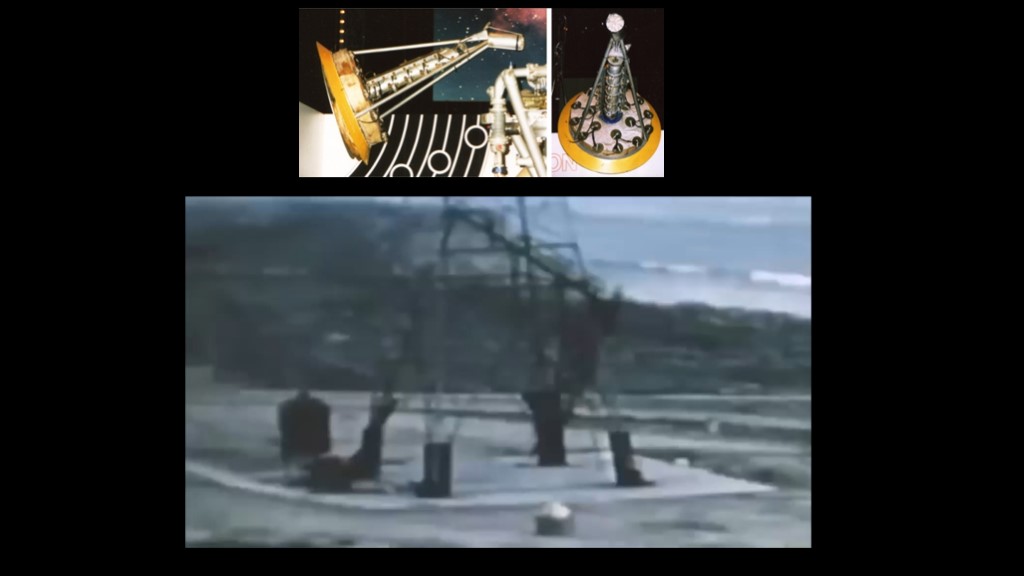
Here's an example, using a test vehicle that holds 5 explosive charges in the central tube.
Let's watch that again. In the second series, you can see the explosives being dropped out of the vehicle before they explode.
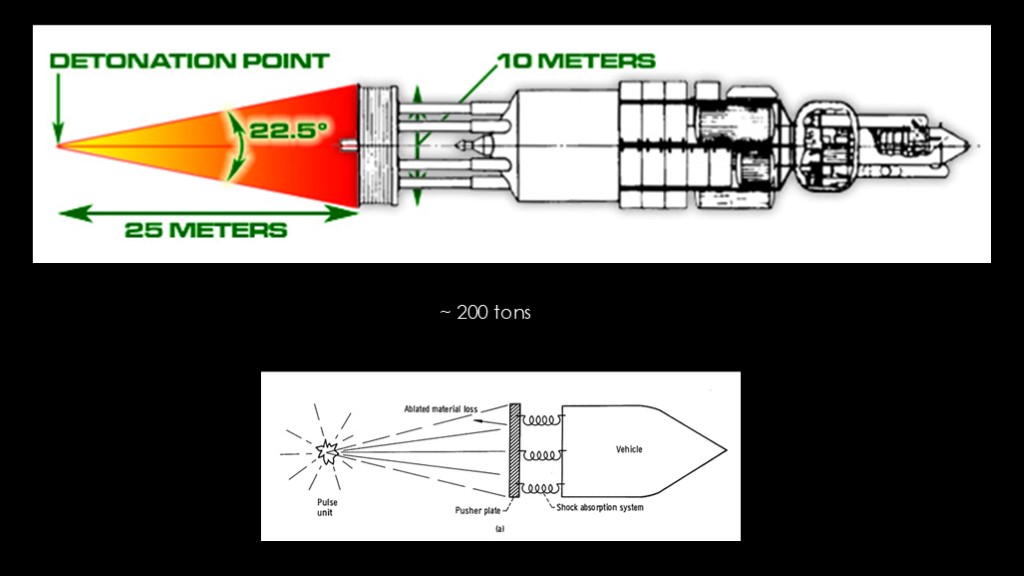
That, of course, was a very small prototype test.
What we need is a reasonably-sized vehicle, like this one, one that could carry a healthy amount of payload. Total mass is about 200 tons.
And we will of course need a more powerful pulse unit.
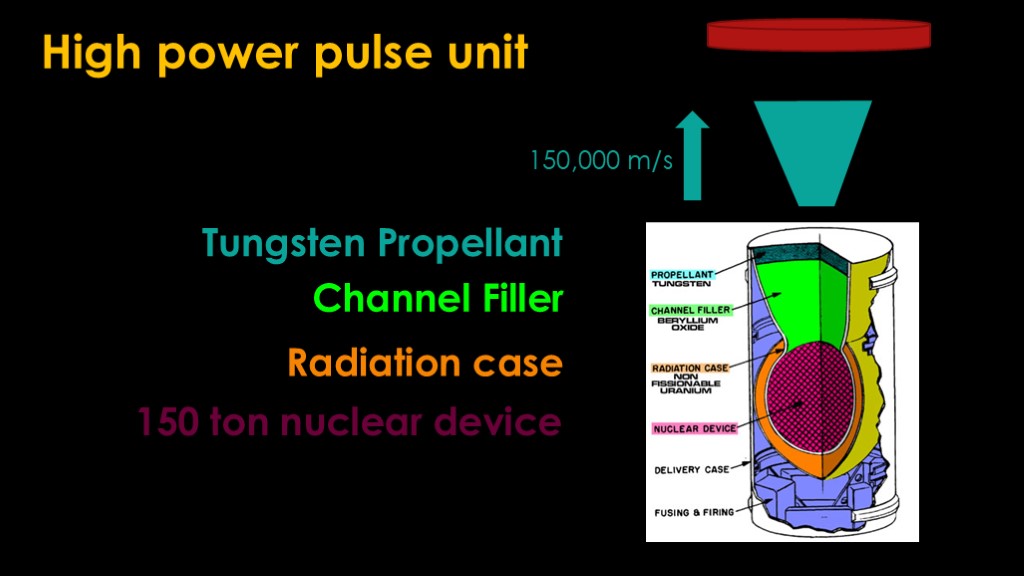
We start with a very small nuclear device, only 150 tons of yield.
We surround the device with a radiation case made of uranium 238, otherwise known as non-fissionable uranium. The purpose of the case is to take the xrays that are created by the nuclear explosion and channel them upwards.
Above that, we have the channel filler made of beryllium oxide. It will absorb the x rays and convert them to heat.
And finally at the top there's a disc of tungsten. The immense heat melts the tungsten and generates a big spray of extremely high-velocity tungsten travelling upwards at speeds in excess of 150,000 meters per second, aimed directly at the pusher plate on the bottom of the vehicle.
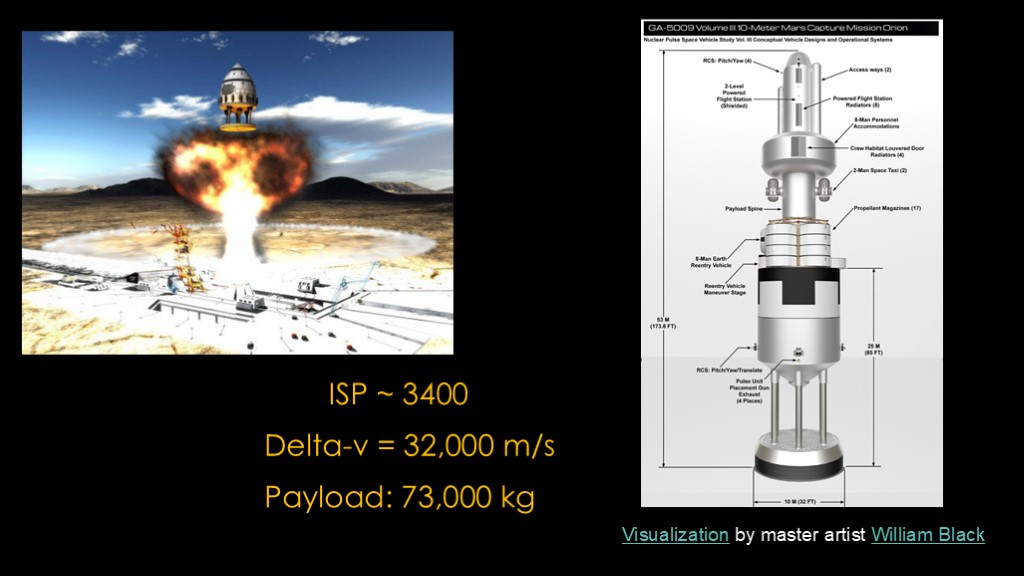
Orion is *great* at getting off the ground and into orbit, as the atmosphere enhances the propulsive effects.
This is the US Air force 10 meter Mars mission Orion. It has an ISP of around 3400, a delta-v of 32,000 meters per second, and a payload of 73,000 kg.
It can go from the earth's surface to mars orbit and back to LEO in a single stage. Easily.
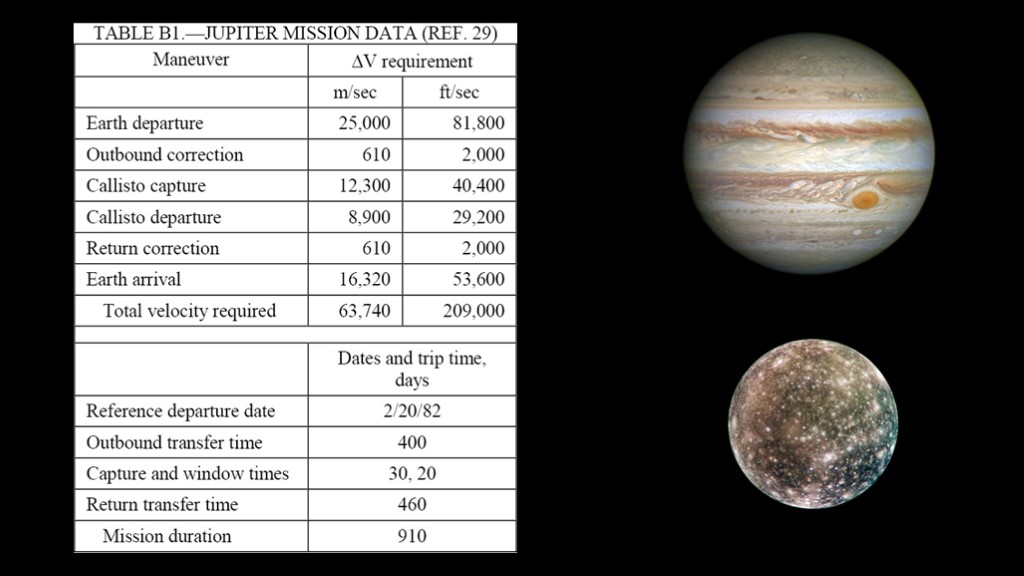
You can even do a trip to Jupiter's moon callisto, with a total mission time of about 2.5 years.
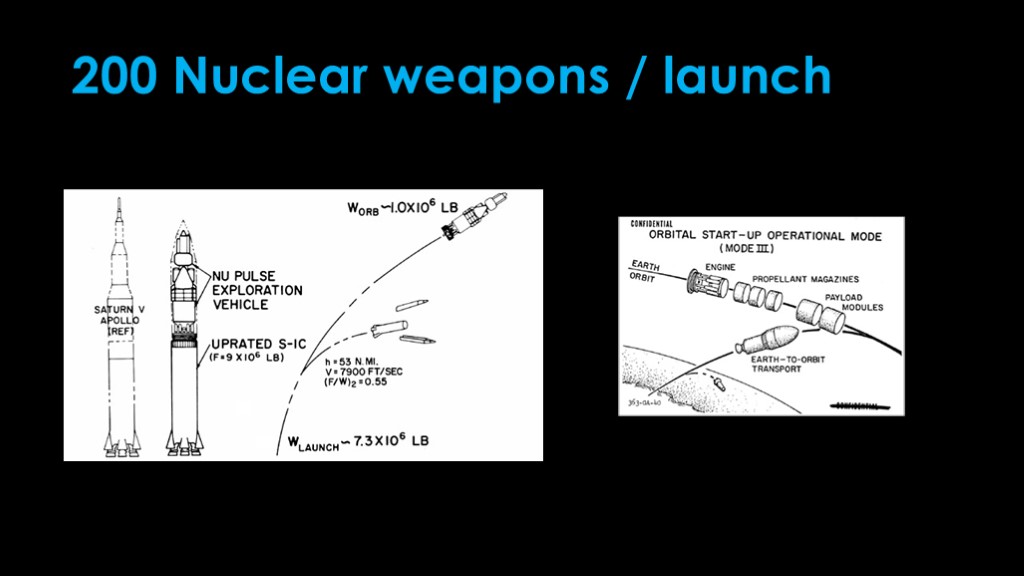
Orion did have a slight downside, the issue that launch would involve 200 nuclear weapons exploding in the atmosphere. That pretty much made it a non-starter.
There were some hybrid designs; here's one of a Saturn V first stage and an orion vehicle on top. It doesn't start using the orion drive until it reaches about 90 km in altitude.
And here's another where you would launch the Orion with traditional rockets and put it together in orbit.
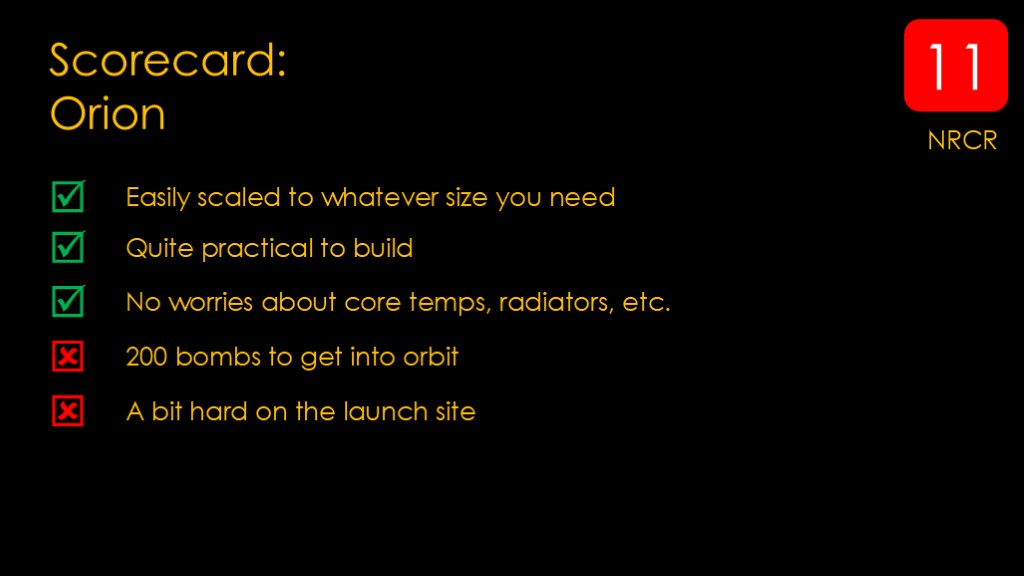
Here's a scorecard for Orion...
On the positive side, it's easily scaled to whatever size you want, and mass is not a problem, and the vehicles are quite practical to build. No worries about core temps, radiators, complex fuel designs, etc.
On the downside, 200 bombs to get into orbit is a lot of bombs, and taking off is a bit damaging to the launch site.
Orion turns the craziness score up to 11

If you enjoyed this video, please buy a nice vidalia at the market.
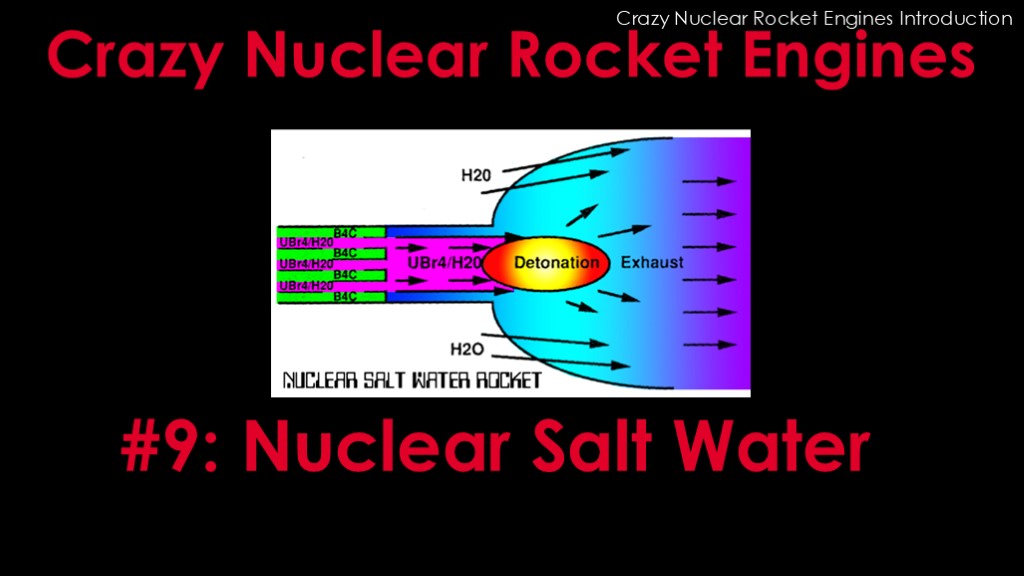
This is episode 9 of the series on crazy nuclear rocket engines, where we will explore the nuclear salt water rocket
If you haven't watched it, please watch the introduction video now.
http://www.npl.washington.edu/AV/altvw56.html

The nuclear salt-water rocket takes a unique approach. Instead of trying to have a controlled reaction inside of the rocket core, it goes for the biggest reaction possible, a "detonation" of the nuclear fuel either inside the combustion chamber or inside the nozzle.
Note that the term "detonation" here is not an editorial comment but the description used by the engine designer
It uses water with 2% uranium tetrabromide in it as a dissolved salt. That is injected at high speed into the combustion chamber and it fissions very rapidly, generating a ton of energy and vaporizing the both the water with the fuel and additional water injected to protect the engine and structure.
The estimated thrust is about 8 Meganewtons - roughly equivalent to the F-1 engine used on the Saturn V first stage - at a specific impulse of 8000.
That is with uranium tetrabromide that is enriched to 20% u-235. If you push the enrichment to 90% uranium 235, that gives a specific impulse of 482,000.
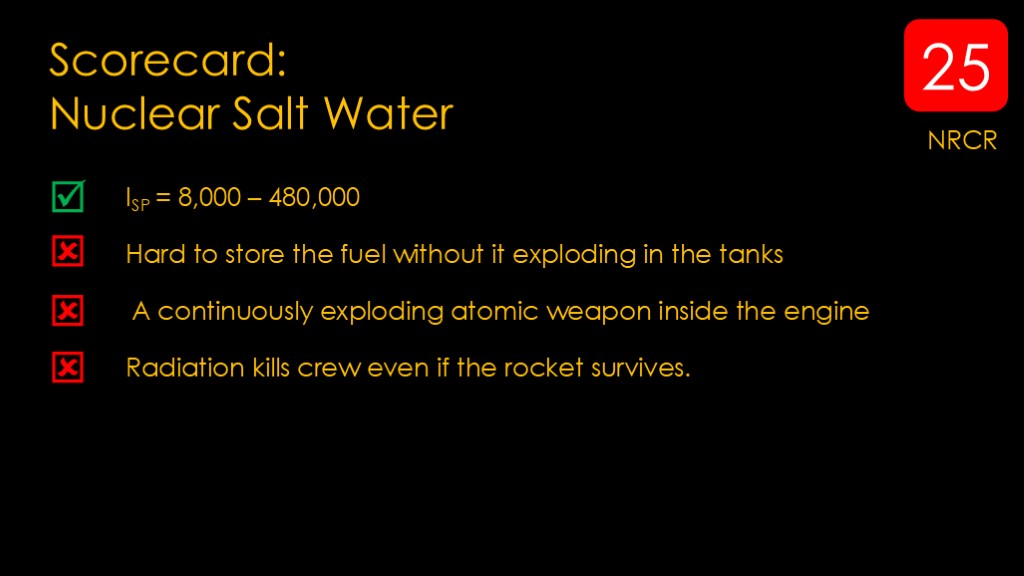
Here's a scorecard for the Nuclear salt water rocket
On the plus side, look at that specific impulse. With highly enriched uranium, it can go anywhere.
On the negatives side...
It's hard to store the fuel without it exploding in the tanks.
It's a continuously exploding atomic weapon inside the engine.
The radiation from the exhaust plume kills the crew even if the rocket survives.
I'm rating it a 25 on the craziness scale, but I'm not sure that is high enough.
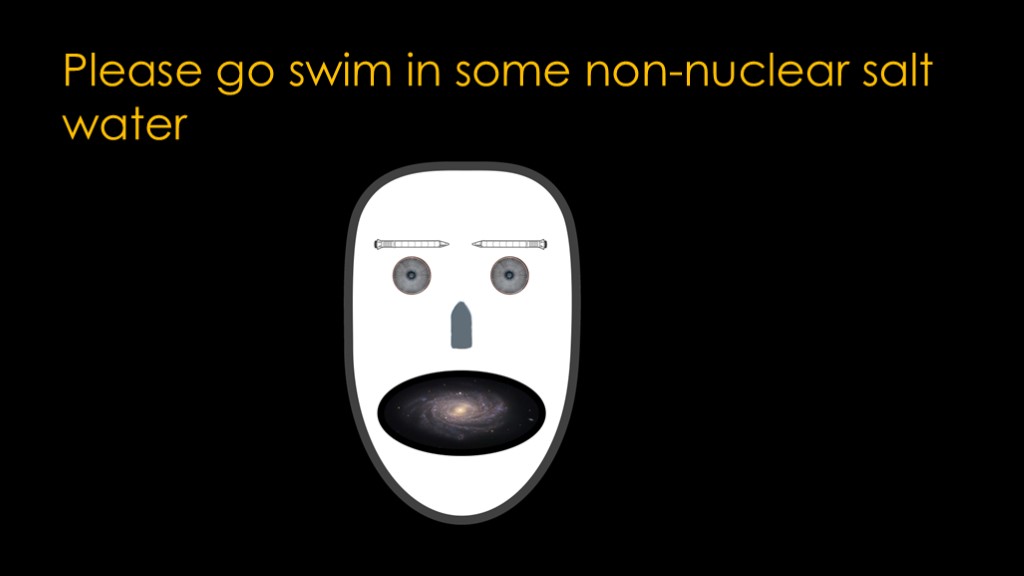
If you enjoyed this video, please go swim in some non-nuclear salt water